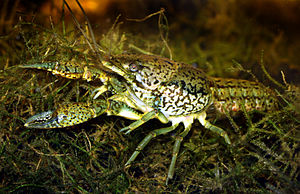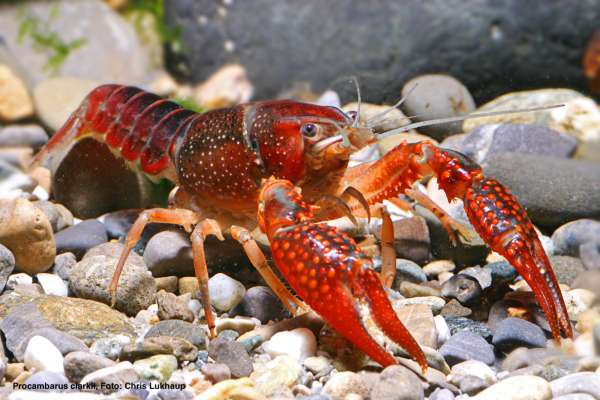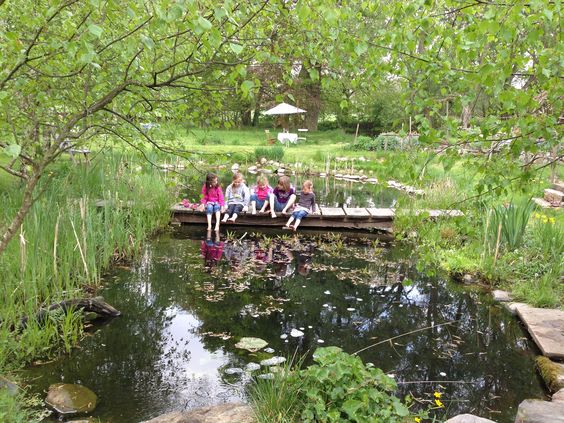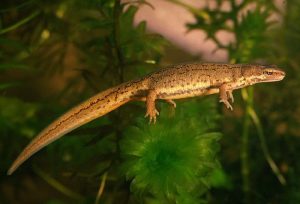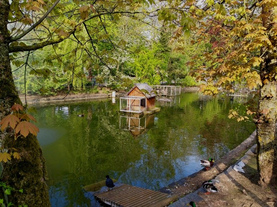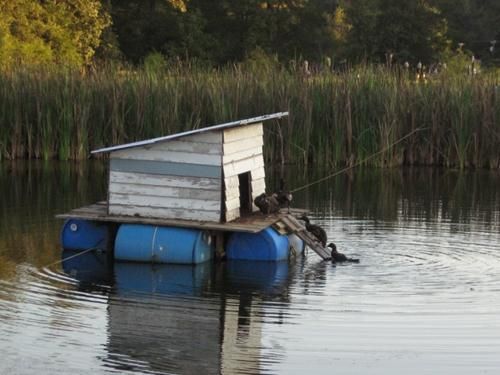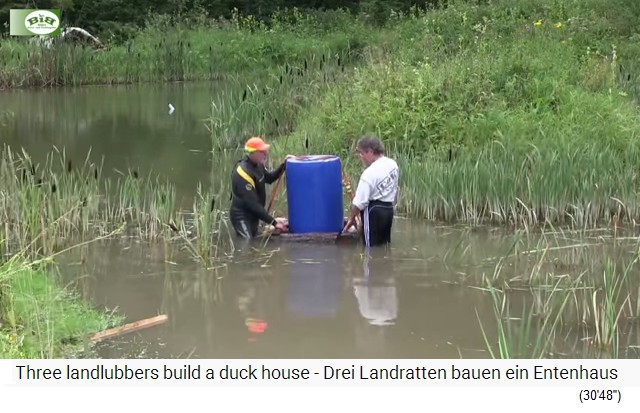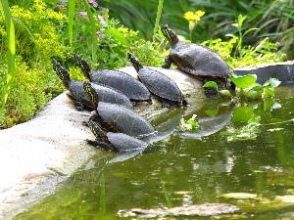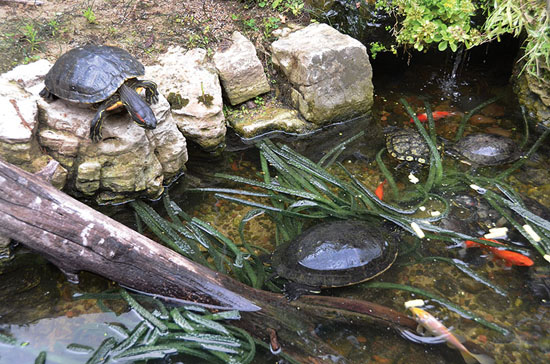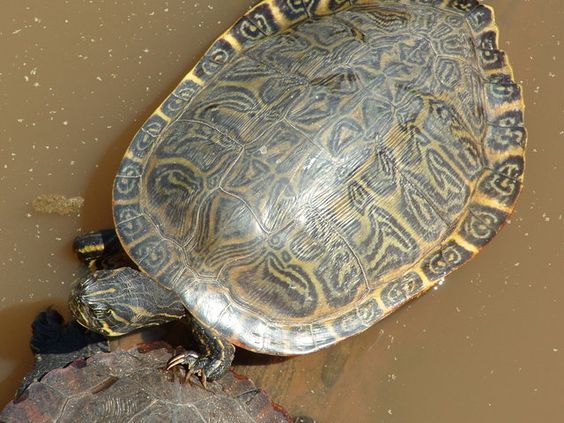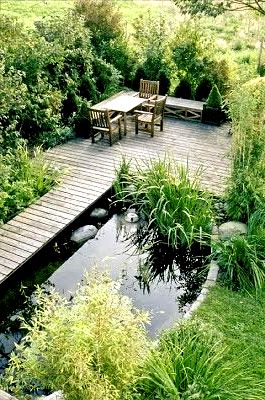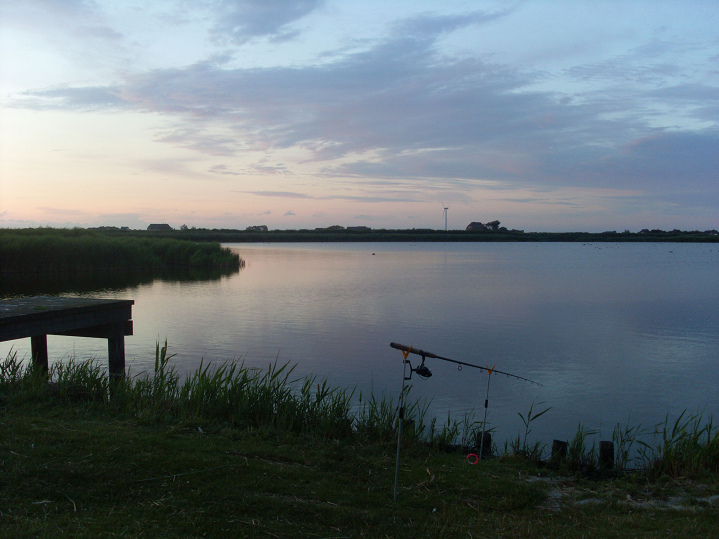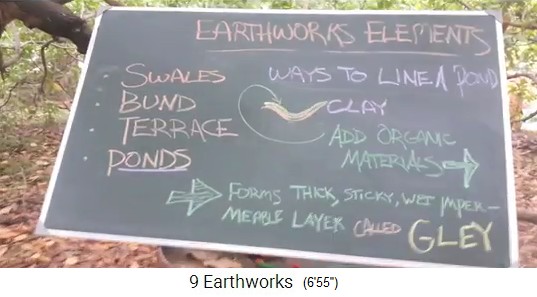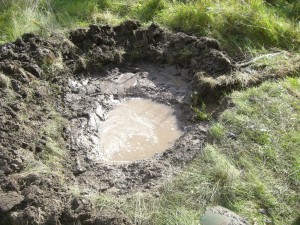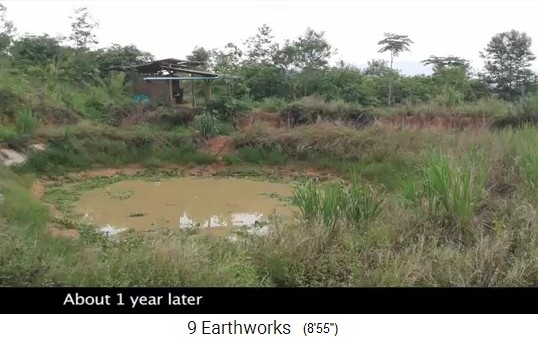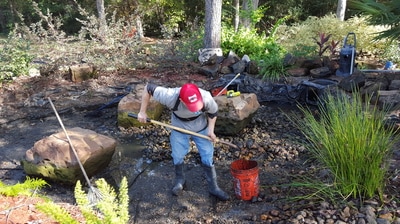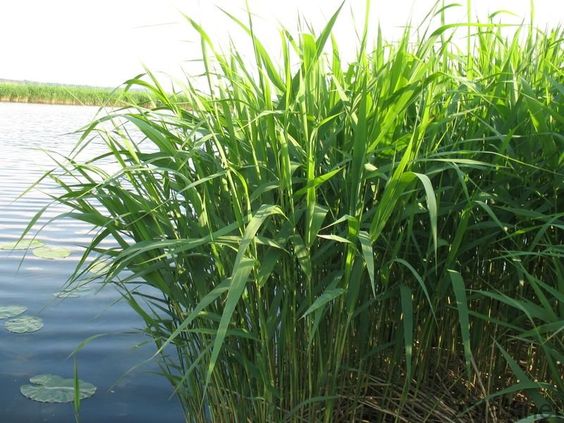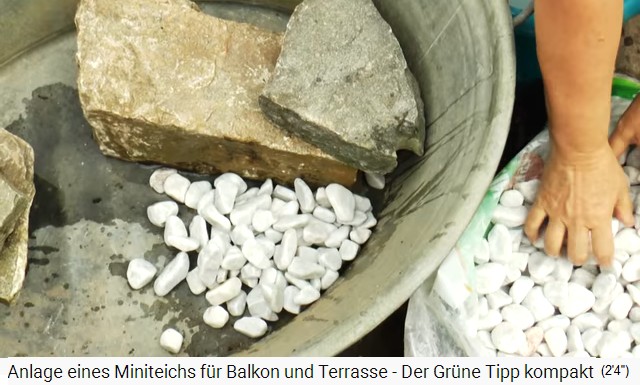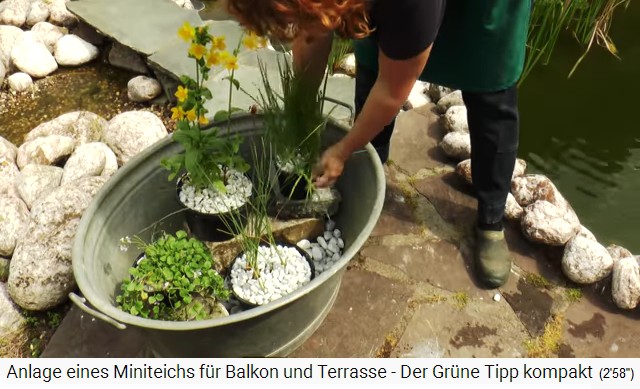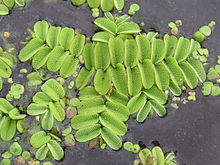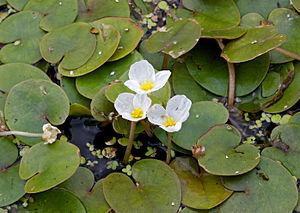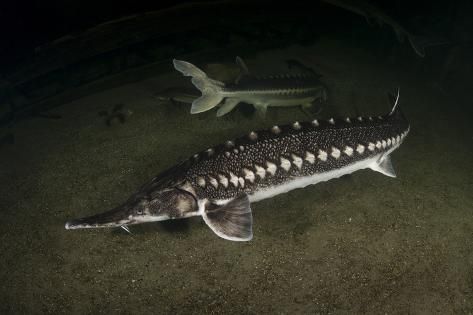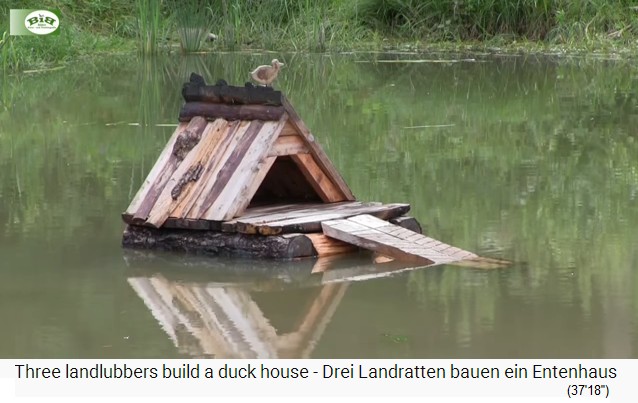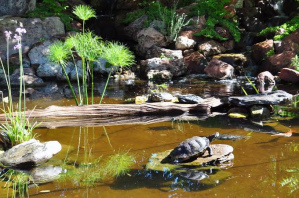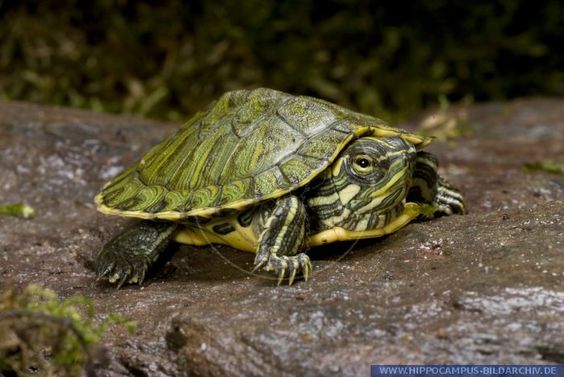Mentioned permaculture zones:
-- Panya projekt near Chian Mai, North Thailand
-- Vanap vegetable farm, India
Literature
-- Book by Dr. Franz Geldhauser & Peter Gerstner: "The
pond farmer" (orig. German: "Der Teichwirt") describing
the basics of pond economy [web06]
4a11b. Pond systems: ponds according to
permaculture
1) Pond landscapes: how it was in former
times
Restore pond systems from before industrialization:
Groundwater levels, water reserves, biodiversity
Ponds and lakes and fen were a natural water reservoir and
a buffer against floods and droughts everywhere until
about 1800. The criminal euphoria of technology in the
"industrialized" countries, starting in the 1700's,
destroyed many ponds and small lakes, the authorities
filled them up with earth converting them into
"agricultural land", not knowing that this destroyed the
natural water buffer and also the water table. Such
original pond-lake buffer systems still exist today, for
example, in Scandinavia or in eastern France between Basel
and Belfort [conclusion Palomino]. Permaculture rebuilds
this buffer system with ponds and small lakes and the
natural water table, natural water reserves and natural
biodiversity are restored [web02]. Deserts become green
landscapes - with a few ponds and lakes (e.g. Sepp Holzer
in Tamera in Portugal -
link).
Biotopes and natural water reserves are "normal" in
permaculture. The side effect is fish breeding, crayfish
breeding and swimming - actually these are all very
positive effects [conclusion Palomino].

Region in France between Belfort and Basel with the pond
plateau / lake plateau - this is how it looked like
EVERYWHERE before industrialization! [1]
This is what the landscape looked like all over the world
when there was no industrialization which destroyed these
precious pond systems!
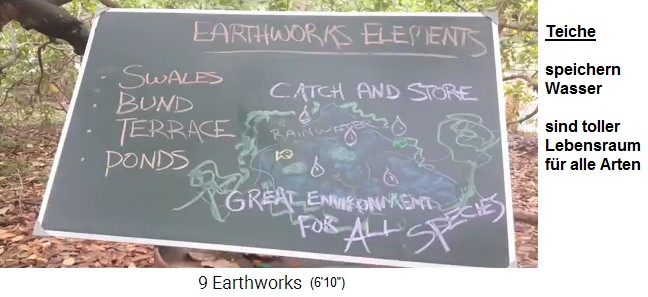
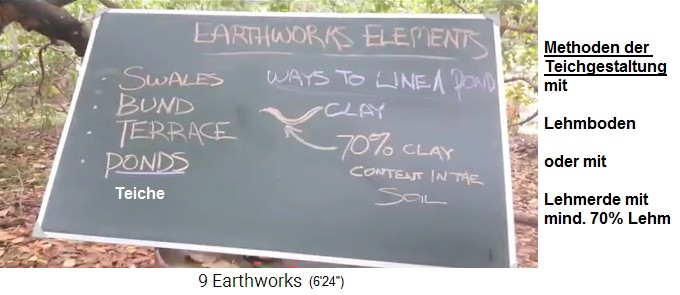
Ponds store water and are a great habitat for all species,
scheme [66] - Pond bottom with clay soil with at least 70%
clay content, scheme [67].
Pond systems guarantee
-- the water table
-- the water reserves in times of drought
-- biodiversity (fish, crayfish, frogs, toads, newts,
aquatic plants, riparian plants, algae, ponds are water
sources for birds, wildlife, etc.).
A single pond alone does not bring much, it should be at
least three different ponds for developping a maximum of
biodiversity [conclusion Palomino].
2) Ponds and oxygen
The oxygen content of water bodies: cold water with a
lot of oxygen - warm water with little oxygen - spring
water without oxygen - the turbulence
The only problem with water bodies is their water
temperature, because the warmer they become, the more the
plants and the animals will grow and consume oxygen, so
the oxygen content in the water will decrease.
Additionally in general, in warm water is less oxigen
soluble so the oxigen content will sink one more time with
it. Every 10 degrees of rise of temperature, the growth of
plants and water animals is doubled. And the more
nutrients are in the pond, the clodier the water is.
Therefore, a pond must be able to keep it's balance itself
alone [web02].
Mountain lakes are cold during the whole year with clear
water, with a high solubility of oxigen in the water, and
with only little growth of water plants or fauna in the
pond. The values of solubility are indicated in this table
with the possible maximum values [web02].
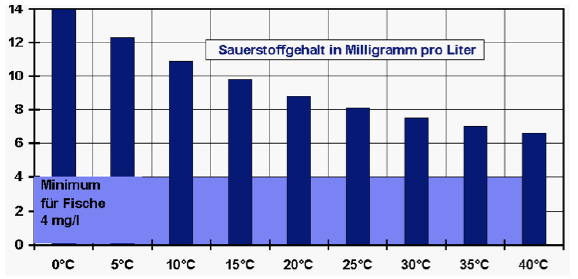
Table: Oxygen content in water in connection with fish
population [3].
Fresh spring water is still without oxygen and has to run
about 50m in the streambed to be oxygenated (by turbulence
[web02]) at the small stones or by small steps in the
streambed [web07].
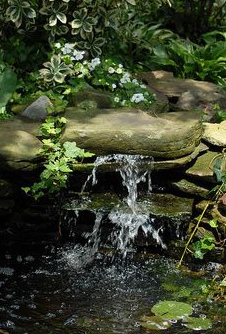
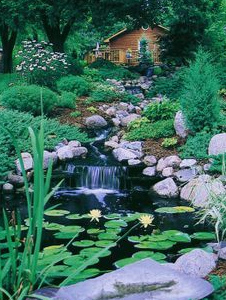
Oxygen enrichment by turbulence with small waterfall
passing stages 01 - 02 [4,5].
The oxygen content of a water body depends
-- on the water inflow,
-- the water temperature, and
-- on water turbulence (swirls, waterfalls),
-- wind increases the oxygen content in the water,
-- underwater plants releases oxygen,
-- phytoplankton release some oxygen [web02].
Clarifying plants that release oxygen: chickwead [web21]
Marsh plants on just under 1/3 of the shoreline [web21].
Solar water pumps can also add oxygen, but mechanical
solutions should be rather avoided [web02].
Winter with frozen waters: Important hollow rush stalks
and stones protruding from the water
In winter with frozen waters, hollow rush stalks and
stones protruding from the water become important for
oxygen exchange. Stones warm up in the sun, the ice around
the stone melts, and gas exchange takes place [web02].
3) Pond construction: approval procedure
Pond constructions in a "closed local area" need a
building permit depending on the size [web09].
Permit procedure
-- the "Lower Water Authority" must give permission for
pond construction: Water loss through evaporation and
water pollution must not be too big [web09]
--
Fishing pond: anyone who wants to build
a "fishing pond" and also fish is terrorized in Europe
with heaps of regulations that are sometimes not easy to
comply with; anyone who wants to fish must obtain a
fishing license [web09], and anyone who wants to offer
their pond to the public as a fishing pond must "either
form a fishing club or register a commercial enterprise
with the tax office, the Ministry of Agriculture, Forestry
and Fisheries, the relevant fisheries inspectorate and the
fisheries cooperative, through which all sports anglers
must be insured." [web09]
Fishing pond on the island of Pellworm
(Schleswig-Holstein, North Germany) [13] -- Fishing pond
in Mährtensmühle southwest of Berlin [19].
--
Ponds in open areas [on large farms]
need permission from the Ministry of Agriculture [web09]
--
Ponds adjacent to a nature reserve also
need permission from the nature conservation authorities
[web09]
-- A
duck pond with a stream connection
must be approved by water authorities [web79].
4) Pond
construction: pond shape - the basin shapes
Basic information about ponds
Distinctions are made between fish pond, swimming pond,
natural pond, fishing pond etc. [web09], also crayfish
pond, frog pond, duck pond, newt pond [web78] etc.
A pond should be at least 80cm deep for overwintering
animals, and at least 3 to 4 times as wide as deep for
good oxygenation [web76].
Ponds in shaded areas must be deeper than in sunny areas,
because shaded ponds freeze more [there is more cold in
the shade and therefore the ice layer becomes thicker]
[web76].
The construction of a swimming pond in the garden with
foil
-- " Excavation of the pond pit
-- Ground straightening (removal of stones, roots, etc.)
-- Subsequent measurement according to the grid
measurement method
-- Prefabrication of the foil parts according to the
measurement
-- For larger swimming ponds and according to the
customer's wishes, the prefabricated foil parts are welded
by us on site (with or without wrinkles, depending on the
soil floor).
-- After that, the swimming pond is filled and planted -
now the swimming fun can begin." [web12]
The pond pit produces earth material, which is distributed
or transported away, goes only with permission [web09].
Pond construction at Pinterest:
https://www.pinterest.de/search/pins/?q=teichbau&rs=typed&term_meta[]=teichbau|typed
Fish farm ponds
-- a trout pond is long and deep and needs cool water
[web09]
-- a carp pond is less deep and needs warm water [web09]
Fish ponds also need planted areas and at least 1m of
water depth for safe overwintering [web08].
Example: a fish pond should be at least 2.5m deep. This
provides a layer of cool deep water, as a reserve for
cooling and as an oxygen supply for warm periods. At the
inflow the water is swirled with a small waterfall, which
increases the oxygen content again [from Beat Rölli:
"Aquaculture in Permaculture" (orig. German: "Aquakultur
in der Permakultur" - web02].
Example: a trout pond should meet the following criteria,
for example:
-- 1 to 1.5m depth
-- the pond should be drainable
-- be elongated
-- have a slope that is not too steep
-- be slightly sloping towards the outlet [Creating a
trout pond (orig. German: Einen Forellenteich anlegen) -
web07].
Fish breeding ponds: Factor pond bottom with slope
The inlet must be higher than the outlet, the height
difference should be 20-30cm per 15m pond length. The
bottom of the pond should have a slope in order not to
have a lot of work when fishing without water: After
draining, all the remaining fish will gather at the
deepest place in front of the outlet, where you can take
them out with pleasure. These slopes in the pond must be
considered from the beginning [web07].
5) Permaculture: The natural pond with
clay soil
-- this can be clay [web23]
-- this can be clay soil [web22] with at least 70% clay
content (7'15-20'') [web31]
-- this can be camelina press cake [web24]
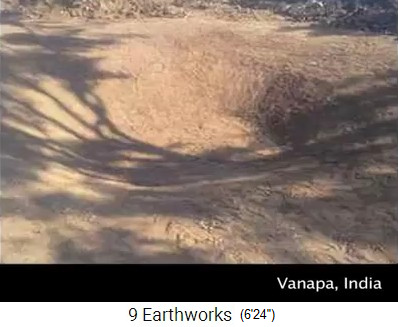

Pond bottom made of clay on the site of the vegetable
farm of Vanapa, India [68] - Pond bottom with the second
layer: camelina press cake [38].
Sealing a pond bottom also works by laying cow dung and
banana leaves or other organic material (6'30''). At the
Vanapa project near Bangalore, cow dung, compost and lots
of green material were used to cover the bottom of a pond.
When this layering dries, this should be dense (6'45'').
Over time, this mixture forms a thick, sticky, impermeable
layer (6'53'') called "gley" (6'54''). This is how many
ponds have been naturally formed (6'57''). [web31]
Arguments for a pond with clay soil (clay soil pond)
-- pond construction with foil is usually much more
expensive, in construction, and especially in maintenance,
and also concerning deconstruction [web23]
-- if a pond has a clay bottom, planting is much easier
-- in later times, mud can be dredged without the risk of
tearing a film
-- PVC film is toxic, clay bottom is not toxic (PVC film
hardens in the sun from UV rays and will be damaged when
the margin is not covered [web36])
-- if the pond silts up, there is no need to take out and
dispose of the foil
-- in case of drought, if the pond has a clay bottom, the
pond surroundings are supplied with the pond water, but if
the pond has a PVC foil, the plants dry up [web23].
So actually it should be international regulation that
only clay bottom ponds are allowed, PVC foils should be
forbidden in nature [conclusion Palomino].
Example: A pond with clayey soil
-- heavy loamy soil is a precondition for a pond without a
liner (foil)
-- or a layer of clay is placed in the pond pit
-- the pond bottom is mudded in and tamped through with
rubber boots
-- at the end, the clay pond bottom is smoothed with a
board and evenly compacted
-- then the pond is filled for the first time and tested
to see if it is tight, if not, it is compacted and tamped
again, but the pond bottom is also allowed to leak a bit
to keep the garden soil moist
-- in the pond, two mounds for amphibians are created
-- then the planting follows [web22].
Example: a water hole becomes a pond with clay soil and
rainwater inflow
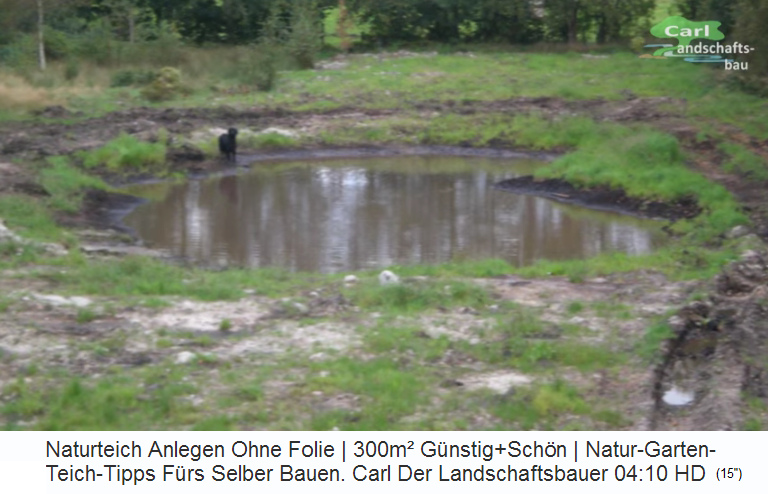
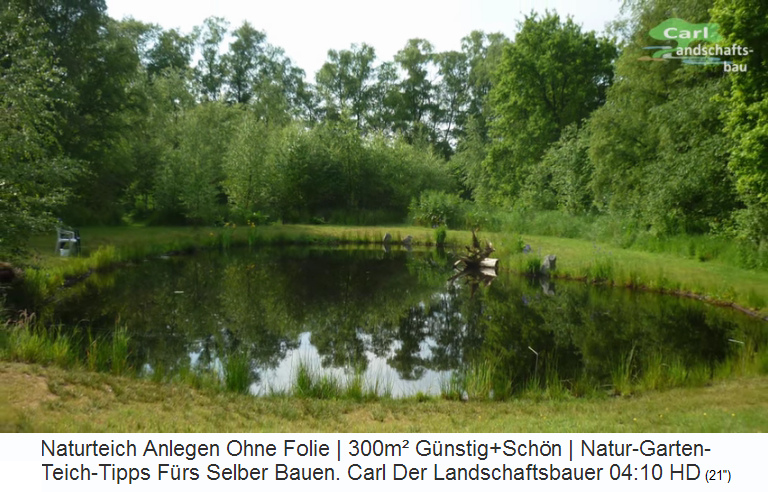
Waterhole with fluctuations up to 1m [39] - Pond with
300m2 surface with hardly any fluctuations [40].
-- a water hole with loamy soil / clay was transformed
into a natural pond with 300m2 surface with maximum depth
of about 2m [web25]
-- as inflow serves a pipe from a rainwater ditch, which
is laid underground, with some slope, but not too much, so
that the water can also flow back when the pond is full,
so the pond will never overflow (so the inflow pipe also
serves as an overflow) [web25]
-- as inflow can also serve the rain water from a house:
Gutters are connected to the pipe between the rainwater
ditch and the pond [web25].
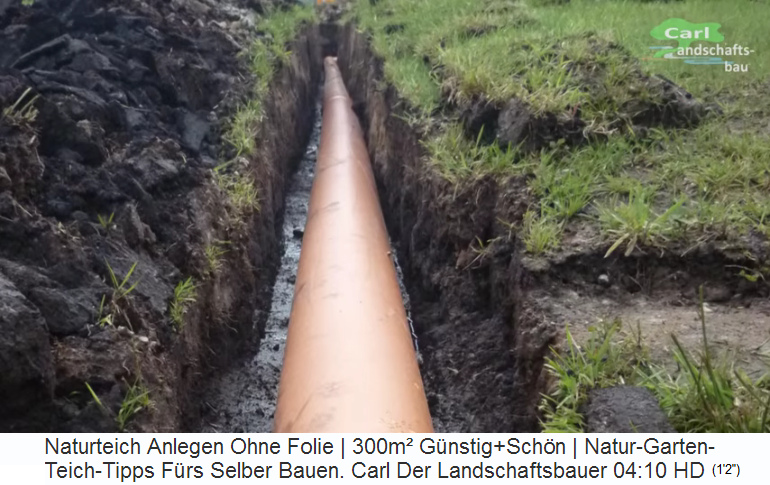
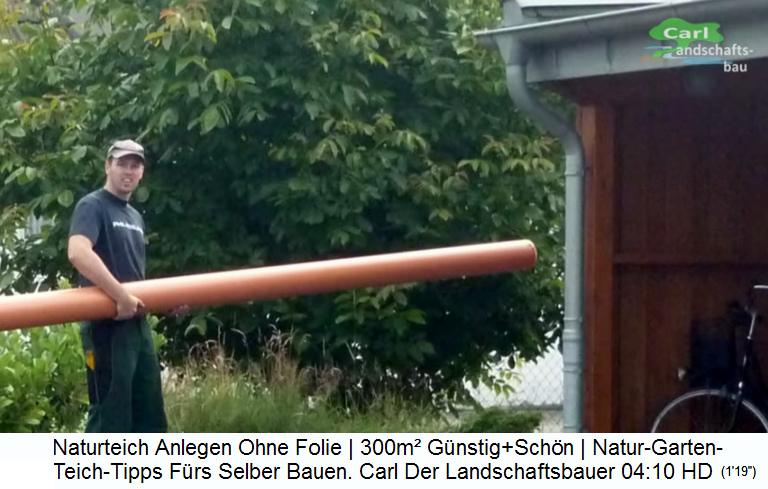
Inflow pipe from the rainwater ditch to the pond [41] -
Outlet pipes for the connection with the gutters [42].
-- the pond can be widened depending on the shoreline
area; steeper shoreline edges created with a small
excavator cause the water surface to remain the same even
if the level drops or rises [web25] [but steep shoreline
edges are barriers to amphibians]

The pond shore edge is made with a small excavator [43]
-- in the end, the ground around the pond is leveled and
seeded, and aquatic plants from surrounding water bodies
are planted along the entire pond edge, you don't have to
move many plants at all, just small plants and runners,
they will multiply quickly [web25]
-- Fish should not be introduced into the pond until the
plant life is well established and balanced [web25]
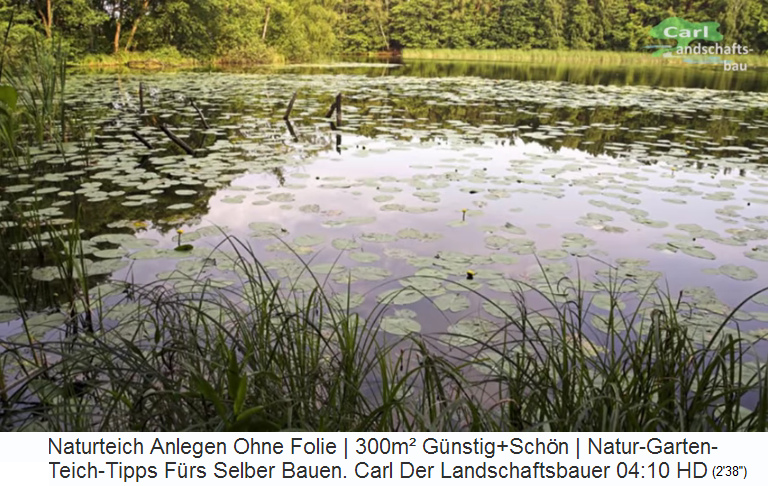
Pond with aquatic plants without end [44]
-- natural ponds without constant inflow and outflow
should support only a few fish, otherwise the pond will be
over-fertilized by the fish [web25]
-- rocks and tree roots sticking out of the water complete
the picture [web25]
-- the only maintenance for this balanced pond with
rainwater inflow consists of mowing the plants and grass
during fall [web25].
6) Example: The construction preparation
for a completely new pond
The position of the pond
-- a pond should not be located in the blazing midday sun,
otherwise it will heat up too much, evaporation and algae
will be favored, the water level will drop, nitrogen
nutrient will increase and algae will be even more pleased
[web37]
-- the pond should not be near deciduous foliage trees,
otherwise a lot of leaves will fly into the pond and
provoke a lot of sludge, nitrogen and algae [web37]
-- so a pond should be in the shade at noon (midday
shade), for example, if a hedge reduces the midday sun, a
bright east-west orientation is optimal for pond and water
plants [web37]
-- already when planning the pond bottom and pond shape,
the later plants should be included, depth of the bottoim,
space requirements [web37]
-- water lilies need 2-3m2, some up to 6m2 -- a pond being
terraced four pond zones: Riparian zone, sump zone,
shallow water zone, deep water zone, always with typical
plants [web37]
-- grasses etc. can be sown on planting cloths - grasses
fortify the embankment - grasses form a harmonious
transition between pond, shore zone and garden
-- plant no more than 50% of the pond, otherwise the
biological balance will be upset and algae will be the
result [web37].
The construction of the clay ponds is always about the
same:
-- good planning of the pond with inflow and slope.
-- dig the pit
-- plow and tamp a thick layer of clay to get all the air
bubbles out and make the bottom as tight as possible
-- set up inlet and outlet
-- fill up and test if the pond is tight
-- secure the pond from strange visitors
-- place aquatic plants, possibly stones, mounds and large
roots
-- put in fish and crayfish, etc [web23].
Details:
Before building the clay natural pond, you need to
determine the soil type. If you are lucky and have a clay
soil, you can save yourself a lot of work! [web23].
If the clay content is over 70%, you can put the pond
right into the clay soil (7'10-20'') [web31].
Now you can put in some fertilizer and some pure clay and
other viscous nitrogen materials if available (7'25'').
Loams vary widely, from bentonite loam to kaolin loam
(7'34'') [web31].
It is also important to know the soil structure and, in
mountainous areas, to know about possible landslides,
where it is not advisable to build a pond, so consult
hazard maps and ask the long-established people [web23].
In addition, there may still be some pipes in the ground,
i.e. electricity, water, gas, telephone, etc., all this
must be clarified on geoportals and at the municipal
administration [web23].
7) Permaculture by Sepp Holzer (Austria):
Clay soil ponds on a mountainside yield climate traps on
an alpine slope - Sepp Holzer, Krameterhof
Sepp Holzer presents his principles for pond construction
on his farm on a steep slope in the Alpes near Salzburg
(from the film: Aquakultur - Sepp Holzer):
-- the ponds should be twisted as much as possible [so
that the sun shines on them as long as possible],
-- the ponds should be protected from cold mountain winds
[the fir trees protect the ponds from the wind, so the
ponds cool down much less],
-- the ponds should take advantage of the sun as much as
possible (35''): The pond reflects the sun, creating a sun
trap so that the environment around the pond is moist and
warm (50'')
-- Ponds need shallow zones, root systems, ditches (55'').
This is where the food animals for the fish multiply
(1'1''), so you don't have to feed the fish then (1'2'').
[web26]
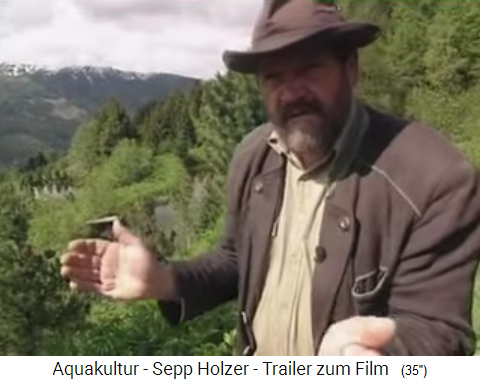
Sepp Holzer erklärt Teiche am Hang [47]
Sepp Holzer explains ponds on the slope [47]
-- when ponds are "planted" in mountain slopes in the
shape of a half moon, the firs protect the pond from the
wind and the warm moisture remains there (1'39'') [web27]
-- Sepp Holzer has large ponds and in them a colorful
mixture of fish, pike and their food fish, the carp
(2'32''), other food fish are minnows, crucians, carp etc.
(2'45'') [web27]
-- big ponds of Sepp Holzer are 4 to 5m deep, rootstocks
and stones vary the ponds (2'57'') [web27]
-- hiding places for the fish are important, so the
hunting fish can't enter there in a root thicket (3'7'')
[web27]
-- these are the resting places for the small fish,
otherwise they will break due to stress or be eaten
(3'21'') [web27]
-- if the many small animals live in the pond, you don't
need to feed the fish (1'5'') [web26]
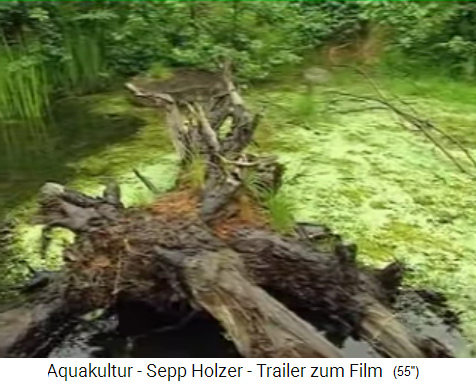
Low zones in the pond with roots+ditches for small animals
in the pond [48]
-- so: the ponds give moisture for heat traps, drinking
water, fish and there is also an own electricity
production (3'45'') [web27] and also crayfish [crayfish on
the Krameterhof -
link].
Further comments on the pond construction by Sepp
Holzer
-- Reader comment: "The best (according to Sepp Holzer) is
loamy soil that is compacted with the addition of water
and an excavator shovel." [web22]
-- Reader comment: "Very important for clay sealing: very
shallow slopes, best 1:4" [web22]
Learning to build ponds with Sepp Holzer: pond courses
with the real stuff
Ponds must have drains and overflows (14'32''). In courses
you learn on the real material and with a watering can
simulating a heavy rain, whether a pond holds or not,
whether the material is right or not (15'17''). And if it
holds in the model, then you can also build a pond or lake
with it (15'28'') [web29].
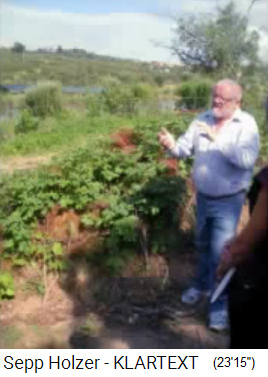
Sepp Holzer explaining [46].
Sepp Holzer's ponds on his farm "Krameterhof": The pigs
consolidate the clay layer / soil layer
Sepp Holzer dug his ponds on his farm "Krameterhof", and
first let the pigs run around in the new pond pits, then
the ponds were filled with water and the pigs were then
allowed to wallow and turn there, and this is how the pigs
consolidated and compacted the earth layer (6'50''-7'15'')
[web31].
[There is no mention of the thickness of the clay layer or
how the pigs' hooves affected the clay layer].

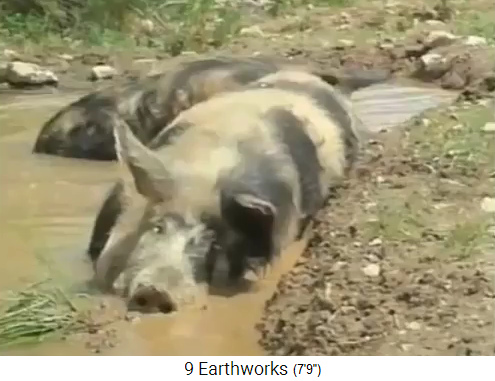
Pond construction on the farm "Krameterhof" of Sepp
Holzer: Pigs press the pond wall in an empty pond pit
[49] - and the pond bank in the full pond pit [50].
Kaolin clay is white and fine, for porcelain production,
etc. (7'38''). Bentonite clay is impermeable to water when
wet (7'43''). The clay particles expand on contact with
water, and water no longer passes through (7'48'').
Fabricators have designed films to lay clay evenly, that
is, the bentonite clay film (7'56''). These clay films are
used in industry to seal containers, and also work very
well in ponds (8'3'') [web31].
Permaculture in Thailand: The Panya project with clay
films in the reservoir
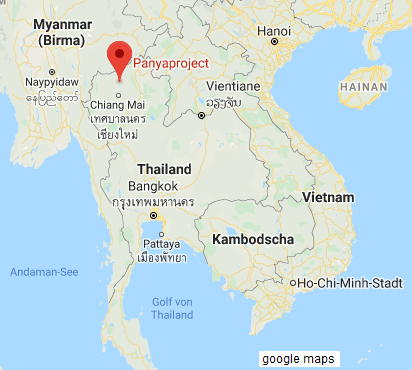
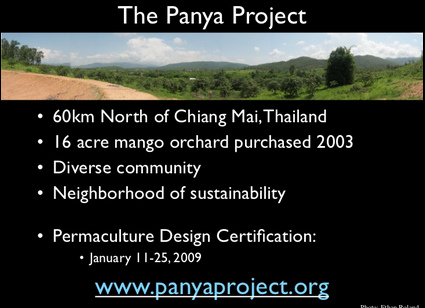

Map of Thailand with the Panya project near Chian Mai [62]
- in Ban Mae Jo (
link
(English) - Panya project: mango orchard 16
acres, permaculture certification since 2009 [63] - The
mango orchard and mangos from the Panya project [64,65].
Interns pay 400 baht ($13) per night, longer stays with
own cottage are no problem, work about 6 hours daily (
link
(English))
The water reservoir of the Panya project: with clay
foils
At the Panya permaculture project in Northern Thailand (
link (English)),
a water reservoir was dug at the highest point of the
territory (8'8''), which turned out to be leaking after
the following rainy season (8'12''). Then a volunteer was
donating 4 industrial rolls of bentonite clay sheets and
in a gigantic group effort the rolls were cut into 16
pieces and the reservoir was lined with them, with
overlaps of 30cm (8'41''). Then another 30cm of soil was
poured on top for more pressure and to hold the clay foils
together (8'46''). Now the pond holds the water (8'53'').
9) Earthen ponds seal themselves off
so says a video from Portugal [web28]
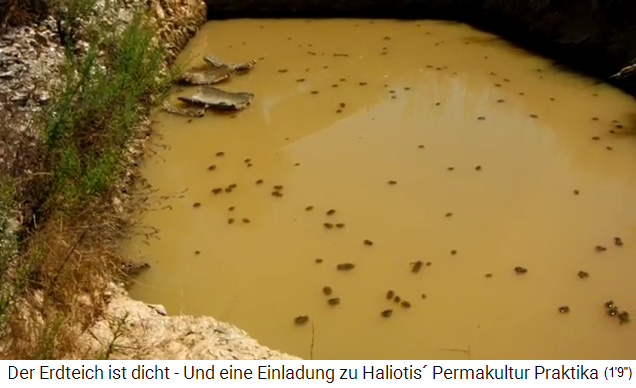
The earth pond in Portugal is dense within 4 years [45]
-- the earthen pond in Portugal was built in 2011 and has
become so dense by 2016 that it has a constant water level
even in summer (1'12'')
-- so the habitat for frogs and newts is stable: tree
frog, water frog, Spanish ribbed newt, marbled newt,
Iberian pond newt (1'34''), and every spring swallows come
to build their nests (1'41'')
-- so the habitat for frogs and newts is stable: tree frog
(Hyla arborea), water frog (Pelophylax), Spanish ribbed
newt (Pleurodeles waltl), marbled newt (Triturus
marmoratus), Iberian pond newt / Boscá's newt (Lissotriton
boscai) (1'34''), and every spring swallows come to build
their nests (1'41'')
-- small rafts made of corn bark (bark of the corn oak)
float there, serving as islands for the frogs (1'57'')
-- floating fern grows in the pond, white water lilies
will follow (2'14'').
[Clarifying plants are missing].
Another means of revitalizing barren landscapes is slash
cystnets (3'30'').
10) Natural dikes are forming a pond
-- with compacted earth dams, e.g. at Armenteras north of
Barcelona [web30]
-- a natural dam with clay soil at Tamera in Portugal
(project by Sepp Holzer) [
link].
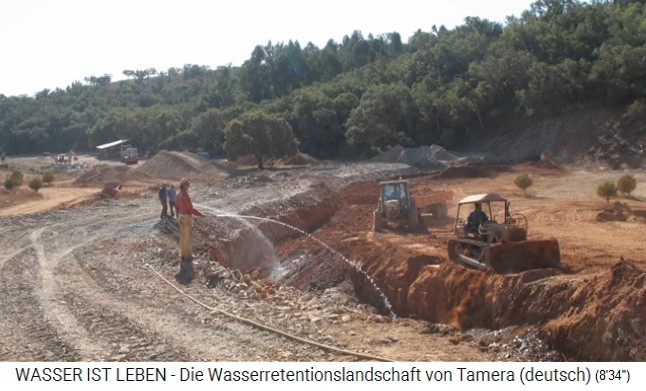
Reservoir dam ditch half full, Tamera, Portugal [111]
-- a stone wall with water furrows in a mountain valley,
e.g. in Africa in Ethiopia [
Link].

High mountain slopes with water furrow so a part of the
water will infiltrate - Aetiopia [110].
11) Pond construction: Other factors:
turbulence - drift - size - discharge / outlet etc.
Factor inflow with turbulence
An inflow should provide at least 10 liters of water per
second, in summer and winter [web02]. The water level in a
pond should always be about the same [web25]. Many water
springs give a lot of water only in winter during
appropriate weather conditions. If the water comes
directly from a water spring, the distance from the spring
to the pond should be at least 50m, because direct spring
water is still without oxygen [web07]. The spring water
accumulates oxygen by swirling with the stones in the
streambed as it flows over the small stones in the
streambed [web02]. [Small waterfalls are best].
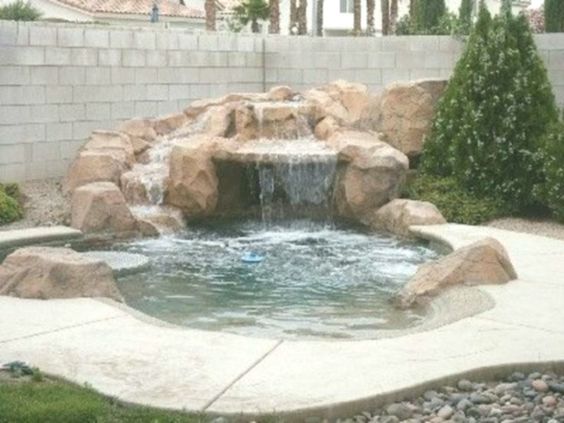
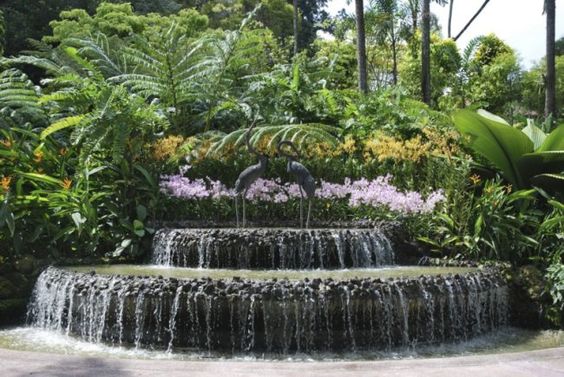
Pond inflow with steps and small waterfall [14] - Pond
inflow with large, round steps and small waterfall with
turbulence to enrich oxygen in the water [15].
Rectangular or oval ponds have the most drift, maximum
surface 20 per 8m. Multiple, smaller ponds are better than
one large one, all should always be drainable. Small ponds
can be drained or fished out faster than large ponds
[web07].
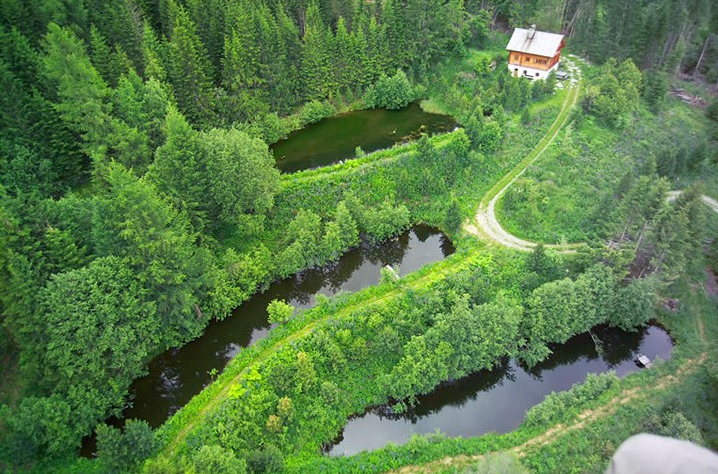
3 Long ponds at the the farm "Kramterhof" of Sepp Holzer
in Austria [16].
The inlet must be higher than the outlet, the height
difference should be 20-30cm per 15m pond length [web07].
The outlet can also consist of a "pond monk" [web09], a
vertical, swiveling drain pipe that can be lowered to
allow the water to run out [web04].

Pivoting pond overflow ("pond monk") in a pond on the
farm "Krameterhof" of Sepp Holzer in Austria [17].
Small ponds can be fished better when two persons handle a
fishing net. If the pond is too deep, the net will never
reach the bottom. If you want to catch all fish radically,
you have to drain the pond. On Sepp Holzer's farm in
Austria, once a year, the fish are sorted by size and
distributed to the appropriate ponds according to their
size [web07].
In case of large ponds, fishing becomes a public festival
[web18].

Fishing a fish pond before cleaning in Austria
Waldviertel 2013 [18]
In spring, there is a pond cleaning: remove leaves, remove
plant remains and algae from the water [web21].
And the second pond cleaning is done in late summer and
early autumn: suction of mud, leaving a thin layer of mud
in the pond [web21]. One should vacuum the mud in the deep
water area to prevent water turbidity due to swirling as
well as algae formation due to too many nutrients at the
bottom of the pond [web33].
At the bottom of the pond, sediment accumulates from:
-- suspended solids [web13]
-- duff (German: Mulm) [web13] (organic particles (remains
from plants and food) and inorganic material (silt and
fine sand) [web19])
-- detritus [web13] (coarse, organic material from plant
and animal remains [web20])
-- lawn fertilizer [web68]
For cleaning ponds, the water must be drained. Cleaning
large ponds can take several days of sludge removing
[web07]. For this work are used pond cleaners, biological
pond cleaners, and also mud vacuums called "Torpedo" etc.
[web21].
-- Remove leaves with a landing net [OBI - web47].
-- Sludge is breeding ground for algae, releases foul
gases such as hydrogen sulfide and methane [OBI - web47]
-- against the foilage of trees falling into a pond you
can stretch a leaf net [web68].
Remove decaying sludge - and use as fertilizer or add
to compost
-- If a lot of leaves fall into the pond, you should fish
them off with a landing net "at least every two days" - a
leaf protection net with 20mm wide meshes protects the
pond from leaves and digested sludge formation [OBI -
web47]
-- Digested sludge can be removed with a bailer on a
handle, or with a pond sludge vacuum cleaner [OBI - web47]
-- Digested sludge is rich in nutrients, is a great
fertilizer, or for compost [OBI - web47].
When in swimming ponds or in fish ponds this sediment
[digested sludge] is wirled up again and again, the water
becomes cloudy and the nutrients of the sediment are
distributed. These nutrients provoke a big growth of algae
[web13]. And therefore get also the algea problems under
control:
-- controlling pH values of the water and hardness of the
water performing a water check (testing pollutants, water
hardness, nutrient content) and special preparations [or
corresponding plants are planted] [web21]
-- already existing algae can be removed, for example,
with a landing net or algae stick [web21].
-- drain the pond regularly and clean the pond bottom
[web13].
-- use a water vacuum cleaner [when the pond has no
outlet] - take the fishes out - clean the pond bottom -
refill the pond - put the fishes back in - clean the
environment:
Remove leaves with a
landing
net, otherwise sunken leaves will become
digested
sludge. The sludge unnecessarily increases the
supply of nutrients in the pond and is thus a breeding
ground for algae. It also releases putrefactive gases
such as hydrogen sulfide and methane, which cannot
adequately escape from the pond under a blanket of ice
and dissolve in the water. The result is a drop in
oxygen levels in the pond water, which can cause a
lack
of oxygen in fish and plants.
13) Cleaning of the ponds: Clarifier
plants

Pond with 300m2 surface with hardly any fluctuations
with clarifying plants in semicircle [40].
The art with a pond is to keep the pollution (excreta of
the animals, rotten plant parts) and the purification in
the pond in a balance (by clarifying plants, fresh water
inflow). Clarifying plants recycle nutrients in the pond
through leaves, through roots, and through bacteria that
live on the clarifying plants so that the water is
purified [Palomino].
"The right amount of aquatic and floating plants will
prevent the spread of algae, but too many plants will
cause the pond to become overgrown." [OBI - web45].
A pond is like a bioreactor and continuously produces
biomass. The biomass is converted with light and heat
[web33]. The biological purification occurs
-- primarily [by clarifying plants and] by bacteria
(microorganisms) [which are on these clarifying plants]
converting and reducing the organic compounds . Required
for this are certain nutrients and especially oxygen
[web33].
Have this quote (translation): plants can
filter the contaminated water:
The effect of clarifying plants (filter plants,
aquatic plants, marsh plants)
"Macrophytes and heliophytes (aquatic and marsh plants)
absorb the resulting fertilizer through their roots and
photosynthetically process it back into biomass. Root
excretion by macrophytes and heliophytes kills harmful
bacteria. Some submerged plants such as potamogeton,
milfoil, water crowfoot, and of course quite a few algae
take up nutrients directly from the water. However, this
only happens in relatively nutrient-rich water ([in
natural ponds without a filter pump, in Austria these
are the ponds of] category 1-3)." [web33]
In fish ponds with a large fish population, at least 50%
of the pond should be equipped with clarification plants
in order to achieve a measurable biological purification
[web32]. Other sources even say that 70% of the surface
should be covered with clarification plants [web33].
Clarifying plants in the pond (filter plants): There
are many clarifying plants for each situation - reed
cleans the most
There are heaps of clarifying plants for ponds, for
different light positions or partial shade, on the shore
or in the middle of the pond in deep positions. Here's a
selection for Europe:
--
Brook Tongue (Veronica beccabunga)
Ground cover, floats on the water at the shore, water
becomes nutrient poor, and thus algae growth is reduced or
prevented.
--
Hedgehog bulrush (Sparganium erectum) on
the banks of ponds, lakes and slow-flowing waters, can
grow in zones up to 80cm depth
--
Juncus species (Juncus effesus): on
low-calcareous soil at the edge of ponds (nutrient-rich
soil)
--
Tangle rush (Juncus conglomeratus): on
low-calcareous soil
--
Sweet flag (Acorus calamus) loves sunny
places, forms dense clumps, looks decorative, with mighty
clumps the roots only hang down into the water, removes
the nutrients from the water
--
Pondweed:
--
Glossy pondweed
(Potamogeton lucens) for deep pond areas.
--
Curly pondweed
(Potamogeton crispus) for shallow pond zones up to 1m
depth, likes partial shade
--
Pennywort (Lysimachia nummularia) on
nitrogen-rich soils, ground cover, floats on the water
with roots hanging down into the water
--
Cattails (Typha species) large and
powerful plants, cattails utilize nutrients through their
roots, form additional roots when nutrients are not
sufficient
--
Reed (Phragmites australis): very stable
plant, enormous nutrient consumption, roots absorb
nutrients and release oxygen, multiplying microorganisms
that in turn consume nutrients [web33].
Floating pondweed roots (Potamogeton natans) can grow
tremendously, should only be planted in large ponds [OBI -
web45].
--
Floating and Flooding Pondweed
(Potamogeton natans and Potamogeton fluitans,
respectively).
--
Sedge (Carex species): between 40-60cm
depth, grows rapidly, forms a dense, upright horst that
continuously widens, roots sometimes just hang down into
the water, very stable plant (assertive)
--
ledges: common pond siskin
(Schoenoplectus lacustris): In ponds and lakes on the
shore and in slow-moving water, can live in deep ponds
over 2m deep
--
Eurasian milfoil (Myriophyllum
spicatum): is often combined with filamentous algae, which
in turn consume oxygen
--
Fir frond: common fir frond (Hippuris
vulgaris) can grow in depths also deeper than 2m.
--
Water crowfoot (Ranuculus aquatilis),
loves shallow pond sites of 40-60cm depth, starts
producing oxygen already in spring, in clean swimming pond
it dies because of lack of nutrients
--
Water knotweed (Polygonum amphibium) in
ponds, ditches, pools and slow flowing waters
--
Water iris / swamp iris (Iris
pseudacorus) in swamps, ditches, pond edges, utilizes
nutrients, forms additional roots when nutrients are
insufficient to consume all nutrients
--
Cyprus grass (Cyperus longus) , up to
40cm depth, grows sideways and downwards into the water
Clarifying plants ("filter feeders") for high circulation
ponds:
-- reed plants, especially Carex family, cyprus grasses,
menth species, etc. [web33]
Submerged plants produce oxygen during the day, but at
night they also consume oxygen and therefore are not as
useful [web32]. In the early morning, oxygen levels are
then at their lowest and life in the pond is threatened
[web33].
Algae consume oxygen [web32]. Algae are indicators of
nutrient-rich or nutrient-poor waters (filamentous algae:
green algae Volvox, armlamp algae: Chara). Green algae are
coming up at certain stone cracks with silicates, iron,
aluminum. These pioneer algae Volvox and Chara then form
first sediments, on which higher marsh plants can develop
[web33].
14) The planting
of ponds
Principle: Don't plant too much: You
shouldn't put too many plants in a pond at all, or the
pond will soon be overgrown "and lots of dead plant
material will degrade water quality." [web76]

Pond planting scheme: with
pennywort, stem flowering grass, bamboo grass,
frogspoon, marsh calla, flowering rush,
calamus (reed), water lily, iris, pikeweed,
buttercup, waterweed [163].
Teichbepflanzung Schema: mit Pfennigkraut,
Stielblütengras, Bambusgras, Froschlöffel,
Sumpfkalla, Blumenbinse, Kalmus (Schilf),
Seerose, Schwertlilie, Hechtkraut, Hahnenfuss,
Wasserpest [163]
|

Pond planting scheme 02: From the shore to the
low point [164].
Marsh
marigold=Sumpfdotterblume
Brooklime=Bachbunge
Yellow iris=Gelbe Iris
Frogspawn=Froschlaich
Tadpole=Kaulquappe
White water-lily=Seerose
Lesser water boatman=Grosse Ruderwanze
Mayfly=Eintagsfliege |
Dragonfly=Libelle
Whirligig beetle=Taumelkäfer
Pondskater=Wasserläufer
Common newt=Teichmolch
Great diving beetle=Gemeiner
Gelbrandkäfer
Amphibious bistort=Wechselknöterich
Water snail=Wasserschnecke
Common frog=Grasfrosch |
|

Pond bank design, scheme [165] |
|
|
Examples of planting ponds: Pond 1 [video - web34]
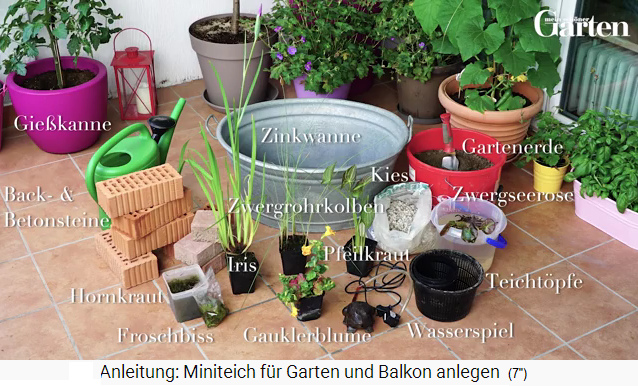
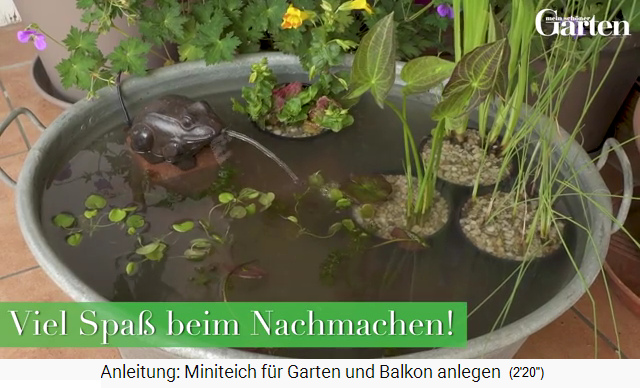
Mini pond in a tub with ornamental and clarifying
plants: Iris, dwarf bulrush, arrowweed, bateleur flower,
dwarf water lily [102] - finished [103].
The plants are placed in pond pots (lattice pots) and
filled with garden soil (21''). Gravel is placed on top of
the soil to prevent it from washing away under water
(27''). Plant the rootstock of the dwarf water lily
vertically (40'') and backfill with soil (52''), then
cover the soil with gravel (1'1''). After planting, you
will only see the shoots (1'6''). The plants in the pond
pots are now well showered and soaked (1'13''). Various
stones with flat surfaces are placed in the tub (here:
bricks with holes). Then the tub is filled with water
(1'28''). The plants are placed in the full tub. Slowly
adjust low plants. Water depth for aquatic plants is
measured from the top of the pot to the water surface
(1'31''). Plants with the top of the pot at the water
surface can be arranged in some way [they just need to
stand well] (1'38''). At the end, underwater plants are
still distributed (1'55''). A small fountain (water play)
simulates life [and enriches the water with oxygen]
(2'13'') [web34].
Examples of planting ponds: Pond 2 [video - web35]
The aquatic plants should not grow too much or not grow at
all, so they must be low-growing aquatic plants (1'3'').
First, stones and washed gravel are placed in the tub,
then plants are placed in pond pots (water-permeable mesh
baskets) with gravel and low-nutrient pond soil (2'25'').
At the end, the pond soil is covered with gravel (2'42'').
The fill should be low-lime rainwater, but tap water from
the garden hose will also work (3'0''). The optimal
location should be in the shade at midday, then the water
does not heat up so much. The water should be refilled
regularly [web35].
Water plants for a small pond
-- small water lilies [web45]
-- Heart-leaved pickerelweed (Pontederia cordata) with
heart-shaped leaves, comes just above the water surface,
the stems grow up to 90cm long [web45]
-- Dwarf bulrush (Typha minima), grows to 80cm tall, the
bulbs grow to 3cm long [web45]
-- Bogbean (Menyanthes trifoliata), grows 20 to 30cm tall,
with white flowers [web45].
Further possibilities:
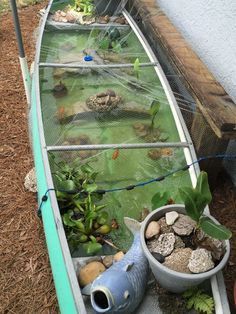
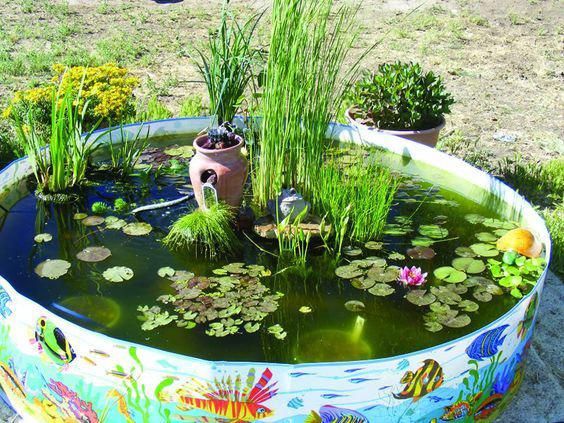
Fish pond made of a canoe [161] - Tub pond in a circle
[162]
Info from Obi [web37]:
The pond planting: the planning
--
Rule of thumb: 2 to 3 pond plants per
m2, no more [web45].
--
Rule of thumb: plant no more than 50% of
the pond, otherwise the biological balance will be lost
and algae is the result [web37].
--
Rule of thumb: native plants usually
have no problem with frost, are hardy, but Asian, exotic
plants hardly grow in the cold or die [web45].
--
Rule of thumb: plan from the beginning
all together: the pond bottom, the pond shape, the pond
plants, deepness, space requirements [web37]
--
A pond has terraced four pond zones:
Riparian zone, marsh zone, shallow water zone, deep water
zone, always with the typical plants [web37]
--
Purchase: when buying pond plants, you
should pay attention to the root balls, should have a
bright color, look fresh [web45]
--
Purchase: aquatic plants are often
offered in a small bag containing gravel, or in a mesh
basket, so put that in a large pond basket with coarse
gravel and sink the whole thing in the appropriate place
in the pond [web45]
-- grasses etc. can be sown on planting cloths - grasses
fortify the embankment - grasses form a harmonious
transition between pond, shore zone and garden [web37]
The pond planting in the different depth zones
-- Planting a pond starts at the deepest part, at the end
the shore zones are planted [web37]
-- Water plants are lowered to the bottom of the pond in
permeable plant baskets, or in plant baskets made of
fabric, the fabric is very effective in preventing the
spread of root runners [web37]
-- Use pond soil [web37], which contains fewer nutrients
than regular garden soil and thus puts less stress on the
pond [web35]
-- Plants are put in spring and then grow in summer with
lots of sunlight -- plant maintenance of the pond plants
is 2 hours per week, then less and less [web37]
-- the aquatic plants with the most water contact are the
most important for biological balance, so the aquatic
plants of the deep water zones are the most important ones
[web37]
--
Water plants of the deep water zone
(from 60cm depth, mostly planted at 1.5m depth) for
underwater plants and floating plants [web45]: Water
lilies, hornwort (oxygen producer), waterweed (oxygen
producer),
floating heart, water milfoil, water
knotweed, tape grass [web37], water starwort, lotus flower
[OBI - web45]
-- the floating heart (Nymphoides peltata) grows from 20
to 50cm water depth, likes to grow in sunny and
nutrient-rich ponds, can spread explosively after a few
years, is therefore unsuitable for small ponds [web45].
-- water milfoil (Myriophyllum) needs at least 30-40cm
water depth and is an addition for tropical looking ponds
[OBI - web45].
-- hornwort (Ceratophyllum)+waterweed (Elodea) produce
oxygen and fight algae [OBI - web45].
--
Aquatic plants of the shallow water zone
(20-60cm water depth): Calamus (Acorus), mare's-tail
(Hippuris vulgaris), Aponogeton (Aponogeton), featherfoil
(Hottonia palustris), bladderworts (Utricularia), great
manna grass (Glyceria maxima), bulrush (narrow-leaved,
broad-leaved - Typha), dwarf bulrush (Typha minima), reed
(Phragmites australis), pickerel weeds (Pontederia),
needle spikerush (Eleocharis acicularis), arrowhead
(Sagittaria sagittifolia), Alisma (Alisma). In some cases,
these plants also grow into deep water [web37]
-- hedgehog bulrush (bur-reed), mare's-tail (Hippuris
vulgaris) or the Alisma (Alisma), arrowhead (Sagittaria),
reed (Phragmites australis) [OBI - web45]
-- the pickerel weeds (Pontederia) with heart-shaped
leaves stands just above the water surface, with stems up
to 90cm long [web45].
--
Aquatic plants of the marsh zone / swamp zone
(0-20cm water depth): Changing water levels are
unimportant: pickerel weeds (Pontederia), Yellow pimpernel
(Lysimachia), Common Reed (Phragmites australis),
Moneywort (Lysimachia nummularia), Cattail (Typha),
buckbean (Menyanthes trifoliata), Asian Iris (Iris
laevigata), common spike-rush (Eleocharis paulustris),
Meadowsweet (Filipendula), purple loosestrife (Lythrum
salicaria), greater spearwort / water buttercup
(Ranunculus lingua), great willowherb (Epilobium
hirsutum), Marsh marigold (Caltha palustris), American
iris (Iris versicolor), Water mint (Mentha aquatica),
Water thickleaf (Crassula aquatica) (on the photo are also
mentioned: Horsetail (Equisetum), swordleaf rush (Juncus
ensifolius)) [web37]
-- Marsh marigolds (Caltha palustris), wild calla (marsh
calla - lat.: Calla palustris) or Japanese marsh iris
(Iris kaempferie blue) [OBI - web45]
--
Oxygen plants are: Waterweed (Elodea
densa), Hornwort (Cheratophyllum dermersum), and Eurasian
Watermilfoil (Myriophyllum spicatum) [web38]
--
Wintering: pampas grass (Cortaderia
selloana) should be tied up to keep it from dying, and
during winter, the roots of the pampas grass should be
protected from the cold with a thick layer of foliage
(tree leaves) [web37].
The water lilies - complicated and partly dominant
-- Water lilies need 2-3m2 of space, some up to 6m2 of
space [web37]
-- Water lilies of the deep water zone partly need a lot
of space for their healthy development, for other water
lilies 30cm water depth and half a m2 are already enough
[web37]
-- Water lilies: are complicated, need a well-functioning
ecosystem, "are relatively susceptible to pests such as
water lily aphids, leaf beetles and brown china mark"
[web37]
-- Water lilies are partly very dominating plants in a
pond, the pond owner has to control very precisely how the
water lily's behavior is described on the package [web45]
-- so you should choose weak growing water lilies for
smaller ponds, with roots at 50cm depth and with a
perimeter (growing width) of 1m: varieties are:
"Rose Arey", "Perry's Fire Opal", "Froebeli" or "James
Brydon", or the dwarf water lily with flowers 2.5 to 5cm
wide [OBI - web45]
-- for medium size ponds is suitable the water lily
"Nymphaea Charles de meurville", with wine red flowers (up
to 12cm tall), grass green leaves up to 20cm tall, as a
fully grown plant it covers 1 to 1.5m2 of a pond's surface
[OBI - web45]
-- for large ponds you can plant rampant water lilies,
e.g. the fragrant water lily, with at least 1.5m pond
depth, with leaves up to 30cm in diameter [OBI - web45]
-- Water lilies can also be restricted in growth by
placing the roots in a sturdy, water-permeable plant
basket, small water lilies with a capacity of 5 liters,
large water lilies up to 30 liters [web45]
-- Water lilies usually overwinter without problems in
ponds which are deeper than 60cm [web37]
-- Water lilies from shallow zones can be placed deeper
before winter starts [web37]
-- yellowed, dead water lily leaves should be cut out so
that they do not sink to the bottom of the pond and form
rotting sludge [OBI - web47]
Duckweed (Lemna)
-- act against algae, is a growth plant and suitable only
for large ponds [OBI - web45].
16) Planting the edge of a pond
You can use coconut foils for planting an edge of a pond
promoting plants to grow there [web37].
There are flowers that are pond edge specialists that can
be planted at the pond edge AND in the pond: Trollflower,
Water Vetch, Meadow Iris [web36].
--
Pond edge beauties are plants that have
the growth forms like marsh plants. You can also stagger
the flowers according to their height of growth, up to a
shrub. Pond edge plants: Chinese reed (Miscanthus), pipe
grass (Molinia caerulea), palm frond sedge (Carex
muskingumensis), meadow iris (Iris sibirica), carpet
knotweed (Bistorta affinis), in the background the shrub
flower dogwood (Cornus florida), which provides shade,
forest honeysuckle (Aruncus), lady fern (Athyrium). In the
sun bloom water astragalus (Eupatorium), candle knotweed
(Bistorta amplexicaule), daylily (Hemerocallis), meadow
cranesbill (Geranium pratense). Pennywort (Lysimachia
nummularia) is ground cover [and in the pond]. [web36]
Chinese reed: grows up to 3m high, is available in
different leaf colors, likes to grow in sunny places,
between the young plants should be 1m distance, so that
the roots can sprout well [OBI - web45].
There are flowers that are pond edge specialists that can
be planted at the pond edge AND in the pond: globeflower
(Trollius europaeus), bonesets (Eupatorium), Siberian flag
(Iris sibirica) [web36].
--
plants of the waterside zone (riparian plants):
Bamboo (there has to be installed a rhizome barrier to
prevent wide spread), Chinese silver grass (Miscanthus
sinensis), pampas grass (Cortaderia selloana), are filter
plants, are (Translation):
"largely hardy also for winter times", "in the transition
between riparian and marsh zone also grow well: Japanese
iris (Iris ensata) and Asiatic iris (Iris laevigata), iris
plants (Iris), muskflower (Mimulus), corkscrew and common
rush (Juncus effusus), preslie (Preslia), Marsh spurge
(Euphorbia palustris), Hanging sedge (Carex pendula),
lesser water-plantain (Baldellia ranunculoides),
Bittersweet nightshade (Solanum dulcamara) and Marsh fern
(Thelypteris palustris), and many more."
(on the graphic also: forget-me-not (Myosotis), funkia
(Funkia), Chinese silver grass (Miscanthus sinensis),
aster (Asteraceae), shade: Japanese maple (Acer palmatum)
[web37].
Bamboo needs a lot of space, nutrients and grows quickly
[OBI - web45].
Plants for the "transition" of the edge of the pond into
the garden: Inuleae (Inuleae), bergenia (Bergenia) or
globeflower (Trollius europaeus) [OBI - web45].
Ferns, ornamental grasses and reeds
give a natural, maritime style to the pond [OBI - web46]:
-- Ferns growing best in the shade on soil: scaly male
fern (golden-scaled male fern - lat.: Dryopteris affinis),
Common shield fern (Polystichum rigens), Mexican mosquito
fern (Azolla mexicana) [web46].
-- Ornamental grasses growing best in the sun on soil:
Buchanan's sedge (Carex buchananii), fescue grasses
(Festuca), pampas grass (Cortaderia selloana) [web46]
-- Reed growing best in sun or partial shade in low water:
Japanese rush (Acorus gramineus), common reed (Phragmites
australis), Chinese silver grass (Miscanthus sinensis)
[web46].
During fall, some ornamental grasses develop feathery
tufts, others bristles. Ornamental grasses are well
combined with summer flowers and perennials which reach
the same height. Ferns have a romantic effect, well
combined with peony (Paeonia), ivy (Hedera helix), lily of
the valley (Convallaria majalis), lilies (Lilium) [OBI -
web46].
17) Care of the pond plants: regular
pruning
-- regular pruning of underwater plants and bank planting
with pond scissors, floating plant debris is fished out of
the pond with a pond net on a handle (landing net) [OBI -
web45]
-- mineral fertilizer to promote growth [OBI - web45]
-- weeding can be done with a weeder up to 30cm long [OBI
- web45]
-- faded perennials can be trimmed (pruned) with a garden
scissors [OBI - web45].
18) Pond plants: algae
Filamentous algae 01 [123] - Filamentous algae 02 [124] -
Leafy green algae (Anadyomene stellata): Photo by Peter
Jonas [125]
There are several types of algae that are growing in
ponds:
Beard algae (German:
Bartalgen)
Blue-green algae (German:
Blaualgen)
Brown algae (German:
Braunalgen)
Thread algae (German:
Fadenalgen)
Floating algae (German:
Schwebealgen)
Slime algae (German:
Schleimalgen)
[web71]
Confusion of terms (translation): "When the matter is
about a garden pond, the algae are normally
floating
algae or
thread algae. Many times also the
terminus
green algae is mentioned. With common
language, floating algae are meant with this, although
thread algae are also part of the green algae." [web69]
pH-value - water hardness - carbonate hardness
pH value: Fluctuations in pond oxygen levels
and algae levels are normal. An alkaline value of the pond
water from pH8.2 increases algae formation [OBI - web48].
Or let's say it like this (translation):
"The optimal pH value for a pond oscillates in a range
between 7.5 and 8.5. The more turbidity and nutrients are
in the water, the higher the pH value rises. If it is over
pH8.5, an algae bloom is not far away." [web72]
Phosphate content (translation): "When the
phosphate content increases to more than 0.035 milligrams
per liter, the living conditions for algae improve."
[web72]
Water hardness (translation): "The hardness
of the water is determined by calcium and magnesium. This
is also called the GH value of the water. A good GH value
for pond water is between 8 and 12 dH. Most pond plants
grow optimally between these values and, in addition, the
development and activity of micro-organisms is optimal in
this medium-hard water." [web71]
Carbonate hardness (translation): "Carbonate
hardness (KH value) is an important pillar in the pond
environment. The KH value is also called temporary
hardness, this is also called the acid binding capacity.
Carbonate is formed by binding free carbon dioxide to
calcium or to magnesium. It thus presents a carbon dioxide
(CO2) source for aquatic plants and algae. A good KH value
is between 6 and 10 dH." [web71]
Lots of algae in the pond means lots of oxygen during the
day (CO2 is broken down and the carbon is incorporated)
and at night, however, lots of oxygen deprivation - can be
dangerous [web69].
When there is a huge amount of algae in the pond, this
means during the day a lot of oxygen (CO2 is split and the
carbon is incorporated) but during the night a lot of
oxygen is used - may become dangerous [web69].
Thread algae (wire algae [web69]): Grow to
several meters long, cover an entire pond if there are
plenty of sun and nutrients [web69], provide oxygen, are
food and hiding place for small creatures such as tadpoles
[web68], beetle larvae and dragonfly larvae [web69];
filamentous algae must be removed with a special algae net
or coiled on a long branch, because otherwise they consume
too much oxygen and release too many new nutrients when
rotting on the ground; then they end up in the compost
[web68].
Algae bloom with floating algae in the pond
(translation): "If one speaks of
algae bloom then
floating algae are meant which multiply explosively. The
water then appears cloudy and green. Sometimes you can't
see deeper than a few inches into the water."
Floating algae like to "bloom" in the spring when
everything is still growing. Then they die and form mulm
at the bottom of the pond [web69].
Algae bloom is caused by overfertilization:
-- apparently too much fish food was given
-- fish defecate too much
-- plants in the pond are planted too densely
-- leaves and dead plant parts consume the oxygen in the
pond water
-- there is too much exposure to sunlight
-- installing the pond, nutrient-rich garden soil was used
for the plants instead of nutrient-poor pond soil [OBI -
web48]
-- clarifying plants and pond mussels are lacking to
filter and clarify the water, and crayfish are lacking to
clean up [conclusion Palomino].
Algal slime (algal scum)
is forming on stones or on the pond surface [web69].
Blue-green algae (former name: blue algae)
[web70]; translation:
"Behind the slimy algae in the pond often conceal
blue-green algae, which, strictly speaking, are not algae
but bacteria. These organisms float on the water surface
forming a fur-like coating on leaves and stems of aquatic
plants. Typically, they have an unpleasant odor." [web72]
Brown algae
grow mainly in deep zones, are brownish to reddish, grow
on stones in the pond or on pond walls, also with only
little light and little food [web72].
Bearded algae
are similar to thread algae, form long stolons, grow
around plant stems, grow in low flow ponds with little
CO2, favored by too much feeding, and they are difficult
to remove [web72].
Danger of drying up
When the algae are ot watched or regulated, the algae will
dominate the pond more and more, the rotten algae will
form a thicker and thicker bottom layer, and so the pond
silts up with time and will be dry land [web69].
Procedure against algae
-- translation: "The bigger and deeper, the slower the
water warms up and the algae does not multiply so fast"
[web68]
-- Put in clarifying plants (nutrient-consuming aquatic
plants).
-- Put small animals (e.g. snails)
-- Organize reduction of solar radiation on the pond so
that the water temperature does not rise as high [e.g.,
install a shade wall with reeds]
-- Organize movement for the pond water
-- Remove thread algae by hand [OBI - web48]
Technical emergency actions against algae
-- reduce the pH value with pH-minus preparations
-- use a biological algae remover [OBI - web48]
-- Apply active oxygen, take the remains out with a
landing net [web70].
Plants against algae
An algae bloom occurs when the "wrong plants" are planted.
Clarifying plants are missing, that are plants which are
giving oxygen and preventing algae growth [OBI - web45]:
-- Dwarf ambulia (Limophila sessiliflora).
-- Frogbit (Hydrocharis morsus-ranae)
-- Hydrilla (Hydrilla verticillate)
-- Hornwort (Ceratophyllum demersum)
-- Simplestem bur-reed (Sparganium erectum)
-- Water pineapple (Stratiotes aloides)
-- Water cabbage(Pistia stratiotes)
-- Moneywort (Lysimachia nummularia)
-- Flowering rush (Butomus umbellatus)
-- Japanese iris (Iris laevigata)
-- Mare's-tail (Hippuris vulgais)
-- Parrot's-feather watermilfoil (Myriophyllum aquaticum)
-- Featherfoil (Hottonia palustris)
-- Duckweed (Lemna)
-- Large-flowered waterweed (Egeria densa)
-- Swordleaf rush (Juncus ensifolius) [OBI - web45].
-- Water lilies [OBI - web48].
-- Frogbit (Hydrocharis morsus-ranae) [web70]
There are more plants against algae: swamp and floating
plants or completely submerged plants that also require
nitrogen to grow and will not allow algae to grow.
Translation: "Plants especially of marshy sites are strong
nitrogen eaters and are suitable for improving pond
quality in the long term."
--
Buttercups: Ranunculus aquatilis or Ranunculus
trichophyllus.
--
Water milfoil: Myriophyllum spicatum or
Myriophyllum verticillatum
--
Waterweed: fast-growing Elodea canadensis or
Elodea densa
--
Bladderworts: fastidious Urticularia vulgaris
or Urticularia minor [web72].
Lettuce against algae
-- with lettuce islands one can cause shade so the pond
doesn't heat up too much [web72]
-- lettuce plants in pots are held together with a
styrofoam ring and float on the pond [web72]
Animals against algae
-- Water fleas eat the floating algae in spring, and then
the water fleas die [web68]
-- Snails against algae [web70]: river snails (Viviparidae
- gill breathers), great pond snail (Lymnaea stagnalis),
and great ramshorn (Planorbarius corneus - lung breathers)
[web72]
-- Fishes against algae: Grass carp (Ctenopharyngodon
idella), common rudd (Scardinius erythrophthalmus -
20-30cm long), silver carp (Hypophthalmichthys molitrix -
up to 130cm long) [web72].
Labor intensive solutions against algae
--
Water change and pond cleaning [OBI -
web48]
--
Water change of 10-20% of the water
volume in 2 days, e.g. with filtered rainwater from a
[covered] rain barrel [OBI - web48]
Trick "vaccinations" against algae: lowering the pH
value of the pond water
--
"Vaccination" with pond water from elsewhere:
pond inoculation with water from a healthy pond: the
microorganisms from the "healthy" pond water destroy the
algae in the sick pond [OBI - web48; web27]
--
"Vaccination" with peat or bark mulch:
You can also make a pond inoculation with peat or bark
mulch, which contain tannic and humic acids, in a closed
net (or in a jute bag [web72]): This lowers the pH value
in the pond water, and at the same time increases the
solar reflection of the pond water, and the algae "go out
of light" -- later the net with the peat or bark mulch
will be pulled out [OBI - web48]
--
"Vaccination" with a thick oak branch:
the tannic acid of the oak wood lowers the pH of the pond
water, algae growth is stopped; (translation): "however,
you have to take the branch out again before it
decomposes", otherwise the decomposition deprives the pond
water of oxygen again [web68]
-- "
Vaccination" with straw in a jute bag:
the rotting of the straw provokes a large consumption of
nitrogen. The rotted straw ends up in the compost or is
used as mulch [web72]
--
"Vaccination" with barley straw pellets in a
jute bag: the barley straw pellets rot, a lot
of nitrogen material is consumed during the rottening
process, the rotten product ends up on the compost or is
used as mulch [web72]
--
Fresh water: when there is much
evaporation, always add fresh water, cistern water [OBI -
web48].
Technical emergency solutions: Pumps+Filters
-- use pumps and UV filters or even an oxidizer
("oxygenator enriching the pond with oxygen") [OBI -
web48]
-- a small fountain keeps the water always in motion and
prevents algae growth [web68]
Technical emergency solutions: hoover algae away with a
skimmer
-- Algae can be sucked off with a mud and pond vacuum
cleaner
-- Thread algae floating freely in the water go away
quickly
-- Algae sticking to rocks or at the bottom will also go
away, with special attachments on the hoover, on surfaces
and in crevices, but small animals like fish or snails
should not be sucked during this process [OBI - web48]
-- Pond skimmer and copper sulfate [web69]
Technical emergency solutions: Algae blocker granules
(pellets)
-- Always dose exactly [OBI - web49]
-- The algae blocker granulate is mixed with pond water in
a watering can and distributed over the pond, this has a
sun reflection effect, reduces the light irradiation and
thus reduces the algae in the pond, also works as a
prevention [web49]
-- Some algae blocker granules contain active iodine and
vital substances "to promote fish health" [web49]
-- pH value or water hardness remain unaffected [web49]
-- Excess phosphate in the water is reduced and the food
supply for the algae is reduced [OBI - web48]
19) Paths along the pond
can be made
-- of path slabs [web37]
-- of ornamental chippings [web37]
Big fish in the pond eat away the water plants
Fishes like the adult koi eat away plants [web32].
If you want to keep big fishes like kois in the pond, you
should create a separate filter trench with clarification
plants, where the fishes have no access. However, a filter
trench has a few cm slope and therefore needs a small
water pump at the end to pump the clarified water back
into the pond [web13]:
20) The filter trench: The biological
cleaning of ponds
-- a filter trench should be located a few cm below the
pond, not far from the pond, on average 75cm deep, contain
20% of the area for a swimming pond, for a fish breeding
pond up to over 100% of the area [web17].
-- the filter trench is densely planted with marsh, pond
and aquatic plants [web13].
-- at the beginning, lime-free stones and coarse gravel
are placed, then reeds and emerses (marsh plants that are
partly above the water level), floating leaf plants, at
the end come water plants that remain below the water
level (submerged water plants) [web13]


Plan of a pond with filter trench 01 [22] - Plan of a
pond with filter trench 02: inner pond (deep) +
semicircle outer pond (shallow) [23].

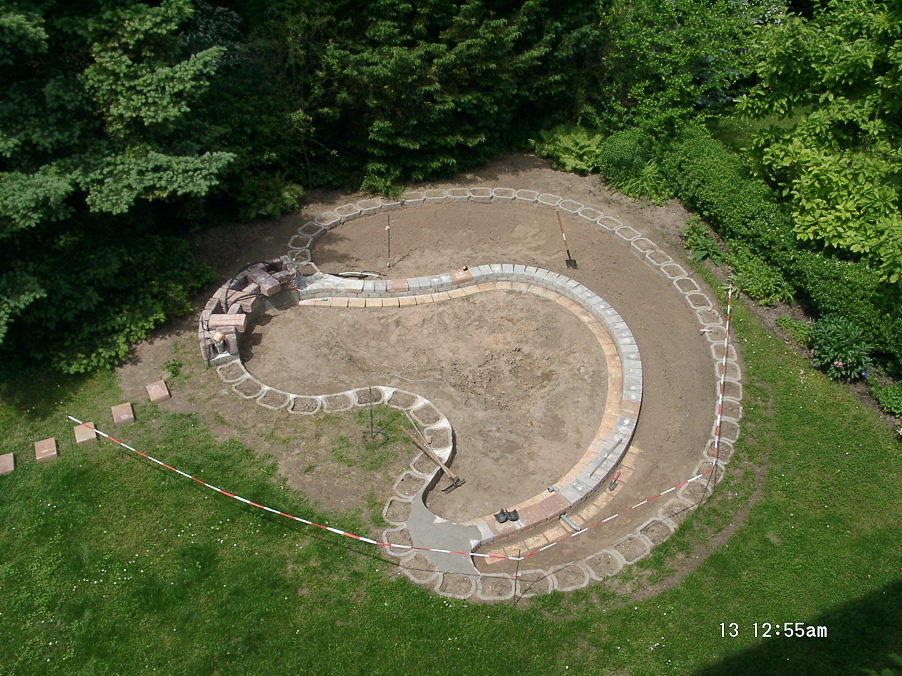
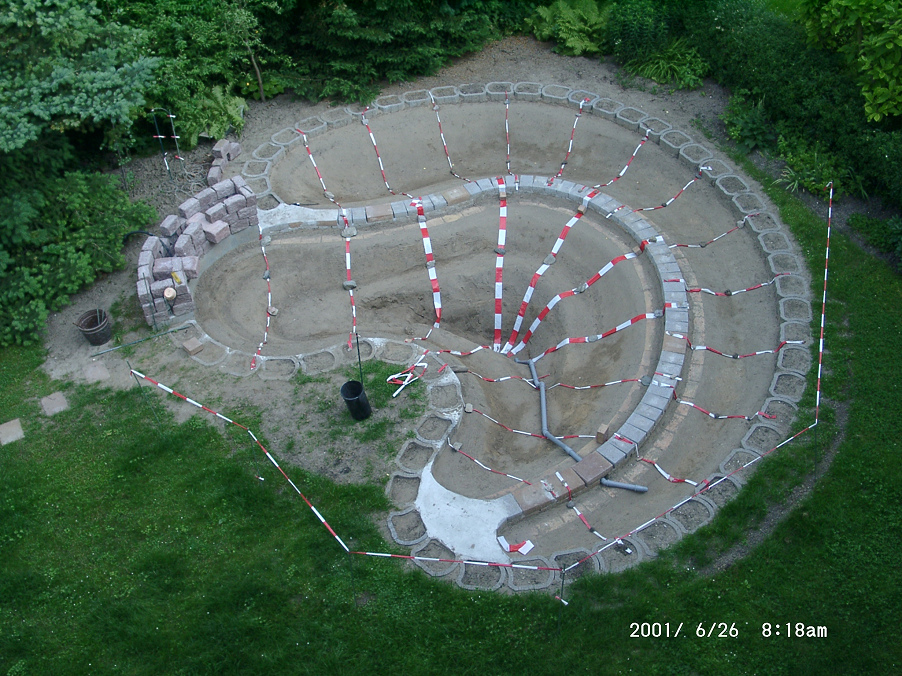
Pond with semicircle filter trench: Construction
progress 01 [24] - 02 [25] - 03 [26].
Then it was laid out with white tile mats (felt mats)
and with PVC film - so everything is quite unnatural,
and in the end it looks like this with a lot of
electricity and wiring:

Pond with semicircle filter trench ready 2005 [27].
consists of substrate material (expanded clay) to breed
many microorganisms that break down the pollutants from
the pond water. Clarifying plants are planted on it
[web17].
Clarifying plants for the filter trench
are for example:
-- clearing plant Sweet flag (
Acorus calamus)  [28]
[28]
- translation:
- "Removes excess nutrients from water, enriches it
with oxygen and thus improves water quality (less
algae growth).
- Flowering time: June-July /// Location: sunny-half
shady.
- Planting zone: pond edge to shallow water (0-20 cm
depth) /// Height of growth: about 60 cm" [web14]
-- clarifying
plant cattail (Typha)  [29]
[29]
- translation:
- "This native hardy bulrush
is especially suited for small ponds or containers
because it does not grow as strong or tall. It has
short cobs that stand above the leaves. In the
winter, the foliage serves as an ice-free barrier,
allowing air exchange in the pond.
- Clarifying plant! Removes
excess nutrients from water, enriches it with oxygen
and thus improves water quality (less algae growth).
- Flowering time: May-August
/// Location: sunny /// Planting zone: pond edge
shallow water (10-30 cm) /// Height of growth: about
60 cm" [web15]
Floating
leaf plants for the filter trench
-- "Floating plants inhibit the growth of algae [web16]
-- Beautiful floating plants give your pond a special
characteristic [web16].
-- Examples: "water cabbage (Pistia), tussock fern
(floating fern [web22] - lat.: Salvinia auriculata),
frogbit (Hydrocharis morsus-ranae), water pinapple
(Stratiotes aloides)" [web16].
Water pinapple is something for the big pond, quickly
forms 100e rosette-shaped leaves that look like aloe vera.
Water pinapple is sensitive to changes in water level [OBI
- web45].
or the water star (Callitriche):
Translation:
-- "This native, hardy, submerged water star forms big
cushions. On the water surface, dainty floating rosettes
of leaves are developped.
-- Clarifying plant! Removes excess nutrients from water,
enriches it with oxygen and thus improves water quality
(less algae growth).
-- Flowering time: May-August /// Location: sunny-partial
shade /// Planting depth: 5-50cm /// Height of growth:
approx. 5 cm" [web16]

-- the filter trench should have a low flow, so that
all large and medium suspended particles can settle
[web13].
-- first, the biggest particles fall on the ground, then
in the zone of the reeds and floating plants fall the
medium partibles on the ground, and last the fine
particles are settling in the zone of the underwater
plants [web13]
-- the filter trench also has chemical reactions
(translation):
"Such a filter trench not only filters floating parts
from the water, but the plants extract nutrients from
the water and muddy bottom, and the bacteria and other
microorganisms break down amino acids to ammonium,
nitrite, and finally nitrate, which is harmless to
fish."
Further (translation):
"If the trench is long enough, in the following zone can
work bacteria denitrifying the nitrate converting it
into gaseous nitrogen denitrifying bacteria can
subsequently reduce the nitrate to gaseous nitrogen,
which is evaporating into the air. In a similar way,
also carbon compounds are reduced and are leaving the
water being installed into the biomass in the plants,
and dissolved phosphate is removed from the water.
Additionally, the underground plants are enriching the
water with dissolved oxygen.
Ideally, the filter trench runs along the long side of
the garden pond. However, care must be taken to ensure
strict separation of pond and trench water along the
entire length of the construction. For this purpose, a
partition wall can be placed between in the ground or a
dam can be built with soil material from the trench
excavation. The partition or dam can be faced with wood
planks or stone slabs and visually connected to form a
single unit."
-- Clarifiers: pond mussels, without fish 1 to 2 per m3,
with fish 3 to 4 per m3 [OBI - web38]
-- at the end of the filter trench, a pond pump with
filter is placed for pushing the clean water back into
the pond [web13].
21) Ponds as water treatment plant (link)
11c
Ponds with reeds are filtering the gray water - the
biological treatment plant
-- Ponds can serve as a biological treatment plant by
planting reeds: Reed bed filtration system can recycle
graywater [web01]
-- Reed is eating nitrogen and works with microorganisms
clarifying the water: reeds consume many nutrients, and
microorganisms populate the reeds. These organisms give
antibacterial substances to the polluted water and
therefore are purifying the water [web10]
-- so when there are built a pre-treatment stage and a
decomposition basin full of gravel, sand and reeds, and a
control basin, one can set up a biological treatment
plants [web11].
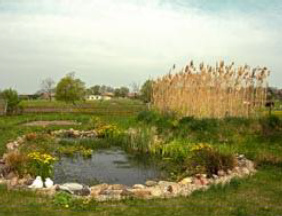
Pond with reed pond (biological treatment plant) above
[2].
-- common reed (Phragmites australis), details (German):
https://www.dehner.de/produkte/schilfrohr-X008313884/
-- book "Tricks with Mother Earth" chapter no. 14: organic
water treatment plant:
http://www.med-etc.com/natur/Ldw-perma/ENGL/BOOK-tricks-w-Mother-Earth-in-agriculture-2019-version03-2oct2019.pdf
Mix in lightly polluted water or material.
Translation:
"Chemically lightly polluted water or material (vinegar,
metal shavings from crafts, house dust) can be mixed
finely among healthy soils, and it will rot during several
years, and the highly creative vegetation will slowly take
of it if it survives. It's just a matter of dose."
[Indication by informant Lake of Zurich, Aug 1, 2019 -
web03]
22) Securing the pond
Ponds must be secured. Because children can get to the
pond and can fall into it and drown and die, and justice
can decide that there was missing any safety measure and
this would be negligent homicide if warning devices and
barriers have not been installed [web09].
23) Pond animals
Teiche produzieren Nahrung
Pond plants take about 12 weeks for establishing well
[web38]. Then fish can be introduced [web38].
Ponds produce food
Ponds provide drinking water or irrigation or fire
suppression, and produce food:
-- edible aquatic plants (water chestnuts (Eleocharis
dulcis), sagittaria, lotus, Vietnamese mint, etc.) [web01]
-- fish and frogs [web01]
-- ducks live in large ponds [web01]
-- crayfish [web04]
-- pond scallops [OBI - web38]
-- ducks, amphibians, water scorpions, water turtles,
insects, etc.
"The final preparation before buying fish is the
water
test. The optimum pH value is between 6.5 and 8.5,
and the carbonate hardness should be between 8 and 14."
[OBI - web38]
The general rule goes like this: For every 10cm of length,
1m3 of water is needed [OBI - web38].
The food for the animals and fish in the pond
-- Algae are the basis
-- plankton is the food for most of the young fishes
-- the fish "common rudd" eats aquatic plants, and
-- the omnivores consume animals on the bottom of the pond
-- trout eat "approach food," and
-- the pike and predatory fish eat the small "feed fish"
[web02].
The more animals and microorganisms in the pond, the more
oxygen is consumed. When it is warm, plants grow more and
consume more oxygen. Also rotting dead plants consume
oxygen during the rotting process [web02].
Animals that clean the pond: crayfish, pond mussels
--
Noble crayfish eat dead plant material,
reducing oxygen consumption in the pond through decay
[web02]
--
Pond mussels are the spawning ground for
bitterlings, pond mussels are filtering the water, and
they are eating the plankton (floating algae) - without
fish 1 to 2 mussels per m3 are sufficient for filtering,
with fish 3 to 4 per m3 - overwintering is no problem if
the depth is sufficient [OBI - web38]
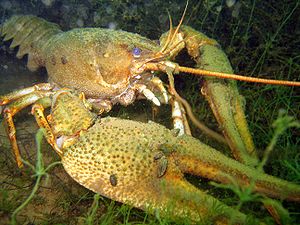

Galician swamp crayfish (European swamp crayfish -
Astacus leptodactylus) [118] - Great pond mussel
(Anodonta cygnea) [122].
Fish breeding and crayfish farming in different ponds
A basic rule is to calculate 20cm of animal length per m2
of pond water [web21].
Ponds for fish farming are special, and for crayfish
farming are special again.
-- small fish need small ponds - big fish need big ponds
[web05]
-- fish farming with spawn need ponds with low zones -
adult fish need large and deep ponds in large, simple
basin shape [web04]
-- during annual final fishing at the end of the year,
fish are sorted and placed in different ponds to
overwinter according to their size [web07]
-- Crayfish need medium ponds with some woody vegetation
in the pond [web04].
Books:
-- Book by Dr. Franz Geldhauser & Peter Gerstner: "The
pond farmer" (orig. German: "Der Teichwirt") with the
basics of pond management [web06].
23-1) Pond animals: pond fishes
Putting in pond fish
Fish should be introduced only when all work with the pond
is completed, because fish are very sensitive to noise
[OBI - web38].
Fish should be introduced in small groups, not all at once
[OBI - web38].
Fish in the transport bag can be placed on the water in
the bag so that the water temperature in the bag adjusts
to that of the pond, or you can collect the fish in a
bucket with the bag water and then slowly add more and
more pond water and release them into the pond after 2 to
3 hours to prevent temperature shocks [OBI - web38].
Pond mussels can be let into the water slowly by hand at
the edge zone of the garden pond, in the deep zones with a
weighted water kettle with a string on the handle [OBI -
web38].
Pond fish
Sunbleak (Leucaspius delineatus), bitterling (Rhodeus
sericeus amarus), minnow (Phoxinus phoxinus), goldfish
(Carassius auratus auratus), ide / orfe (Leuciscus idus),
tench / doctor fish (Tinca tinca), pumpkinseed (Lepomis
gibbosus) [web08].



Pond fish sunbleak (
link)
[74] - bitterling (Rhodeus sericeus amarus) (
link)
[75] - minnow (Phoxinus phoxinus) (
link)
[76]
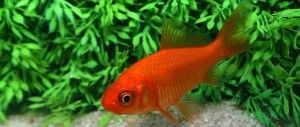
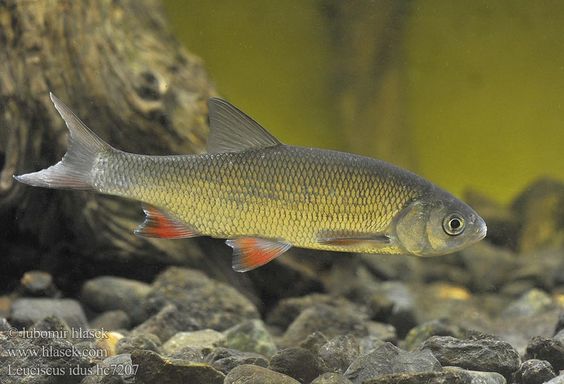
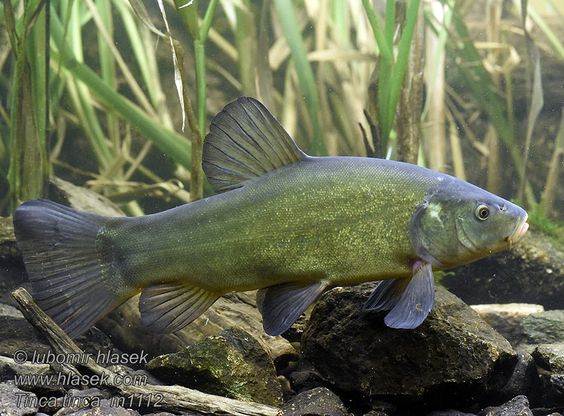
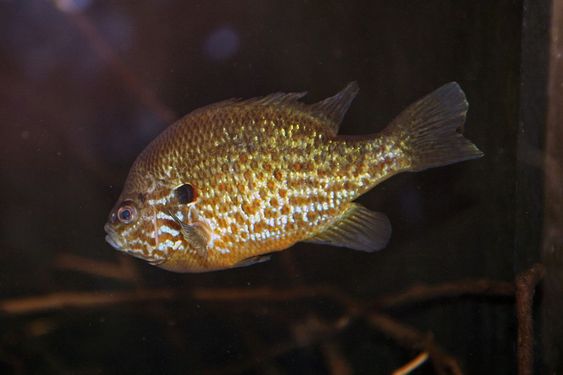
Pond fish gold fish (
link)
[77] - ide / orfe (Leuciscus idus) (
link)
[78] - tench / doctor fish (Tinca tinca) (
link)
[79] - pumpkinseed (Lepomis gibbosus) (
link)
[80]
Goldfish breeding forms:
-- Shubunkin (scarlet patterned goldfish from Japan -
[web40])
-- Veiltails (Carassius gibelio forma auratus) [OBI -
web39] (this cultured form probably comes from China
[web41]).
Orfe fishes:
-- Gold orfe (Leuciscus idus - [web42])
-- Blue orfe are mostly swimming near the water surface
[OBI - web39]




Cultivated gold fish variations: Shubunkin from Japan (
link) [112]
- veiltail (Carassius gibelio forma auratus) (
link)
[113] - gold orfe (Leuciscus idus) (
link)
[78] - Blue orfe (Leuciscus-idus-caeruleus) (
link)
[114]
-- common nase [OBI - web39] (Chondrostoma nasus) [web43]
-- Gudgeon / gobio gobio [OBI - web39] (Gobio gobio)
[web44]
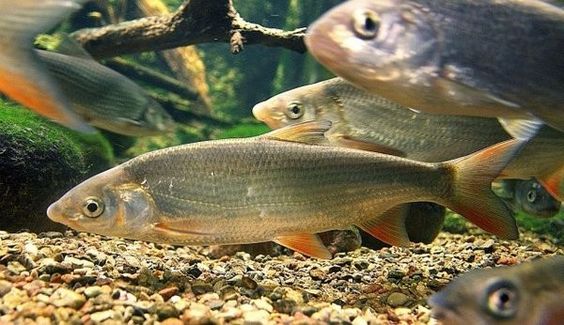
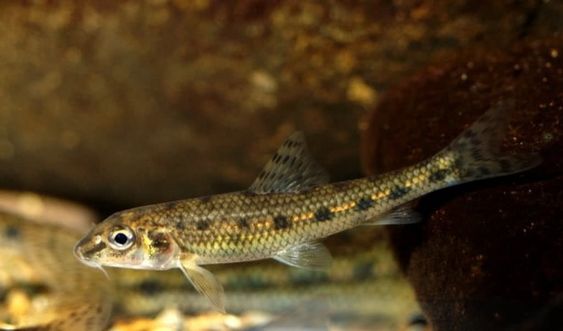
Nase (Chondrostoma nasus) (
link)
[115] - Gudgeon / gobio gobio (Gobio gobio) (
link)
[116]
-- Bitterlings (at least 10 animals) [OBI - web38]
-- Sunbleak (15 animals) [OBI - web39]
-- Minnow (15 animals) [OBI - web39]
-- Goldfinch (at least 10 animals) [OBI - web38]
-- Goldfish, shubunkin, veiltail (min. 8 animals) [OBI -
web39]
-- Gold orfe and Blue orfe (at least 8 animals) [OBI -
web39]
-- Gudgeon [OBI - web39]
Characteristics in pond fish: The tiny fish (up to 10cm
long).
-- Fish have different requirements. Euryecious species
have low demands and a wide tolerance range, stenecious
species have high demands and a narrow tolerance range.
Thus, the pond owner must know exactly which fish can live
where in which pond zones, and the size of which fish
species [web02].
-- Bitterlings grow to 9cm long, they like to swim at the
water surface, they need pond mussels from the region as
spawning sites to lay their spawn in the mussels [OBI -
web39]
-- Sunbleaks become 6-9cm long, like to swim at the water
surface [OBI - web39]
-- Minnows grow to 6-9cm long, like to swim at the water
surface, need clear, running water, eat dry food and
remember the place where they "eat", become trusting [OBI
- web39]
Characteristics in pond fish: medium size (up to 40cm
long)
-- Gudgeons grow up to 15cm long, need clear, running
water [OBI - web39]
-- After a draining action, carps can be left on the mud
for a while, not so the trout [web07].
-- Nases grow up to 40cm long, eat algae away from the
plants [OBI - web39].
Fish in a mini pond
-- Bitterlings combined with pond mussels [OBI - web39]
-- Sunbleaks [OBI - web39]
-- Minnows [OBI - web39]
Fishes for large ponds and lakes
Pond and lake fish:
-- koi carp (Cyprinus carpio) [web08],
-- small sturgeon: sterlet for larger ponds, starry
sturgeon (Acipenser stellatus) in very large and deep
ponds [web08].
Koi carp (Cyprinus carpio) (
link)
[81] - Japanese koi carp (Cyprinus carpio) (
link)
[82], Sterlet (Acipenser ruthenus) (
link)
[83]
-- Koi carp are descended from river carp and always need
fresh water supply, need constant water changes, cannot
tolerate pollutants or pathogens [web32]
-- Koi carp have an long shape that corresponds to river
life [web32], growing up to 80cm long [OBI - web38],
unlike pond carp with a pan shape [web32]
-- Koi carps are warm water fishes, their immune system
and digestion are working from 15/16ºC on, they develop
normal life at 18ºC, comfort temperature is from 20ºC, at
which koi fish then grow - koi fish are therefore fish for
indoor ponds in large halls with large water supply, this
is rather a show [web32]
-- after spawning, high ammonium and amonia levels develop
[web32]
-- adult koi destroy all plants in the pond eating them
[web32].
Unsuitable fish for ponds
-- Grass carp (Ctenopharyngodon idelle) eat away all pond
plants and only as their final dish, they will eat algae
[web08, OBI - web39]
-- Three-spined stickleback (Gasterosteus aculeatus)
reproduces en masse [web08, web39] and is a predator:
eating tadpoles and the spawn of other fish, destroys the
balance in the pond [OBI - web39]
-- Stone moroko (Pseudorasbora parva) is a carp fish with
a huge reproduction [web08] and eats the food of other
animals [OBI - web39]
-- Pike (Esox lucius) also eat frogs, crayfish, water
birds and small mammals, grows rapidly and eats away
everything that moves [web08], young pikes from 8 to 9cm
tend to cannibalism, eating their conspecifics, then they
should be fished off and given to fishing clubs [web09]
-- Common perch (Perca fluviatilis) is a predatory fish
[OBI - web39]: eats fishes, newts, frogs [web08]
-- large sturgeon: grows to 2 to 4m, becomes absolutely
too large for ponds [OBI - web39].
Fish diseases always come from the pond above
Fish ponds located above can transmit fish diseases to
ponds below if there is a direct connection [web07]. If
ponds are relatively small and always have their own inlet
and outlet, any disease transmission from pond to pond can
be avoided [web09].
Diseases are also possible through bird flight [web07].
Fish diseases in pond fish include.
-- white spot disease (parasite)
-- finrot (parasite)
-- fish leech (parasite)
-- Spotted fever? (German: Fleckenseuche) (bacterium)
-- Saprolegnia (fungus)
-- Wobble disease? (German: Taumelkrankheit) (fungus)
-- Gill rot (fungus)
-- abdominal dropsy+pop eyes (virus) [web22]
23-2) Pond animals: crayfish and noble
crayfish are the cleaning crew in the pond
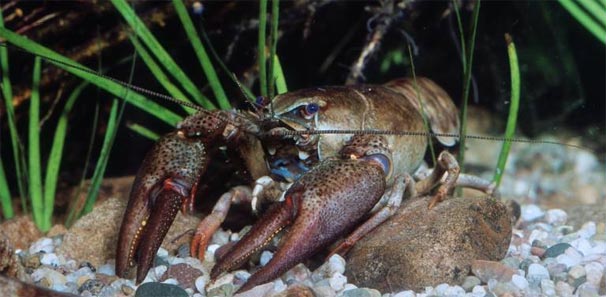

Europäischer Edelkrebs (Astacus astacus) [117] -
Galizischer Sumpfkrebs (Europäischer Sumpfkrebs -
Astacus leptodactylus) [118]
-- You can buy young crayfish and put them in the pond,
they stay in the pond and don't cost much [web56]
-- Crayfish in ponds are climbers and also use aquatic
plants as "pillars" to crawl up from deep depths [web56]
-- Male crayfish are very combative with each other, even
to the point of cannibalism [web55]
-- Crayfish sometimes attack humans during mating season
when there is some work to be done in the pond [web57]
-- Crayfish are taken out of the pond with a fish trap to
reduce the population [web55]
-- November is the mating season (northern hemisphere) and
the males are looking for females also during the day
[web55]
-- Crayfish are nocturnal and you don't see them during
the day except in November (northern hemisphere), or when
they have emptied the pond and are hungry [web55]
-- Crayfish hibernate like the fish [web57]
-- Crayfish keep water clean, do not need to be fed
[web50]
-- Crayfish eat rotten, dead organic material (leaves,
dead algae) [web50], other websites think crayfish don't
eat leaves [web58]
-- Crayfish thin out reeds so that only the healthy culms
remain, they eat dead fish, they avoid creating
decomposition and sludge [web50]
-- Some websites indicate that crayfish don't eat live
plants because they are much harder to chew than dead
material [web50]
BUT
-- other websites indicate that crayfish also eat
"anything else they can reach (tadpoles, insect larvae,
pond plants, etc.)" [web54] [this means: if you have
crayfish in your pond, you have no frogs in your pond and
hardly any insects on your pond]
-- Crayfish become active during the day when they have
"pretty much emptied the pond" [web55]
-- Crayfish eat ponds empty: they prefer soft plants, but
generally the following counts (translation): "Crayfish
will eat anything, even like the fall leaves that always
end up in the pond", sometimes crayfish will eat away
plants you would rather keep [web55]
-- Crayfish eat away aquatic plants, e.g., the fringed
water lily [web58]
-- With crayfish, the water of a pond becomes totally
clear again [web50]
-- Crayfish make pond water clear and clean and make water
pumps or water filters SUPERFLUOUS [web51]
Noble crayfish (Astacus astacus)
-- Occurs throughout Europe, but not in Great Britain and
not in the Iberian Peninsula [web60]
-- Lives in stagnant waters and in riparian regions of
streams and rivers [web60]
-- Males about 16cm long, weighing up to 150g, older
animals weighing up to over 200g, females up to 12cm long,
weighing 80-85g [web60]
-- Noble crayfish live only in cool water with gravelly or
sandy substrate [web54], above 25ºC noble crayfish stop
eating but remain in the pond [web55]
-- Recommended is about 1 crayfish per m2, pairs of
crayfish will have big crayfish families [web50], as a
cleaning column 3 to 5 crayfish per m2, then they need
many hiding places which can be arranged in a pond [web55]
-- Large fish population in the pond keep the crayfish
under control [web55]
-- Noble crayfish (Astacus astacus), should not be
confused with the "American" signal crayfish (Pacifastacus
leniusculus) [web52]
-- Noble crayfish were a common source of protein in the
human diet until 100 years ago [web53]
-- Noble crayfish are nocturnal and need good shelter
during the day [web52] such as rocks, roots, clay pipes,
etc. [web50], caves [web52], damaged clay flower pots,
etc. [web51] - so for the crayfish these are "family
homes" [web58].
Swamp crayfish
-- Swamp crayfish live in muddy soil underground and do
NOT need shelter, for example the Galician swamp crayfish
(astacus leptodactylus) [web52]
Crayfish in rivers
-- live in riparian areas in running waters (e.g. the
noble crayfish)
Stone crayfish (stream crayfish - Austropotamobius
torrentium)
is the smallest crayfish species in Europe, lives in
mountain streams and mountain lakes [web64].
White-clawed crayfish (Austropotamobius pallipes)
can be found in Southern Europe, Western Europe and
Southern Central Europe [web63]
The "crab fence"
-- Some websites think you have to put a crayfish fence
around the pond or they will walk in the garden
[web50,web51]
-- Other websites think that crayfish only leave the pond
when the water is about to tip over, or when there is too
little food [not enough rotting material, rotting leaves,
wood] [web52], when there is too little oxygen in the pond
water, noble crayfish go ashore and then breathe air
[web59]
-- A reader's comment says that noble crayfish naturally
dig, climb and migrate several 100m [web52]
-- Adult noble crayfish sometimes leave the pond and
migrate elsewhere, but young crayfish (yearlings) do not
[web55]
"American" crayfish
-- "American" crayfish don't need special conditions (are
undemanding), live in any water and on any surface [web54]
-- in mamor crayfish (from Florida [web61]), females
produce their own offspring, and produce so many offspring
that European crayfish species are threatened [web54]
-- the "American" signal crayfish also lives in sunny
ponds, leaving the pond at water temperatures above 28ºC
and hiding in the earthy environment under tree roots,
under rotting logs, etc. [web55]
-- the Red "American" Swamp Crayfish (Louisiana Swamp
Crayfish [web65]) is also sold in the crayfish trade under
the name "pond crayfish", [as a marketing trick to release
it into ponds and eradicate the European crayfish species]
[web64]
Extinction of the European noble crayfish by "American"
crayfish - cancer diseases
-- when "American" signal crayfish are put in a pond in
Europe, they eliminate European noble crayfish, so that
the European noble crayfish has been on the Red List for
some time [web52].
--
crayfish plague (fungal disease with a
tubular fungus Aphanomyces astaci) was introduced to
Europe by importing "American" crayfish [web53]
-- European crayfish species such as noble crayfish or
stone crayfish die from crayfish plague, but "American"
crayfish species do not, noble crayfish and stone crayfish
have been reduced to a few water spring areas [web52]
-- noble crayfish have been virtually wiped out in the
last 120 years, primarily by crayfish plague (causative
agent: Aphanomyces astaci) [web60]
BUT ALSO (translation):
-- "Due to water pollution, stream straightening, and much
more, our crayfish were severely decimated at the end of
the 19th century" [web55]
-- Besides by bank mowing and too many natural predators
like eel, walleye and perch [web60]
-- Crayfish plague has almost wiped out European crayfish,
crayfish enthusiasts are organizing new ponds to prevent
extinction [web55].
The fungal spores infect the European cancers, spread in
the body, destroy the vital organs, loses its legs and
claws, dies in agony, from the corpse come millions of new
zoospores and seek new victims. Zoospores die in water
after 10 to 15 days. Only the "American" crayfish are
resistant. Once all European crayfish have been destroyed
and all exotic crayfish have been removed from the pond,
wait 6 months as a "safety buffer" and new noble crayfish
can be introduced [web53].
Chronology [web62]:
~ 1860: first occurrence in Europe in
the area of the Po River in Italy.
1875 France
1880 Central Europe (e.g. Austria: 1879
[3])
1890 Russia
1893 Finland
1900 Bulgaria
1907 Sweden
1978 Spain
1981 British Isles
1982 Greece
1985 Turkey
1987 Norway
--
Criminal crayfish trade: The crayfish
trade continues to sell the dangerous, exotic,
multicolored crayfish for aquariums, which then eat
everything there, so that they are ALWAYS put outdoors in
the end, and then the crayfish plague continues wiping out
the native crayfish species, warnings [and punishment!]
are missing [web53]
-- [there should be a clear IMPORT BAN of exotic crayfish
for Europe]
-- one single exotic crayfish with crayfish plague spores
can infect pond water or infect any technical instrument,
so crayfish plague is also spread via infected pond water
or pond devices [web53]
-- in one case, 3 liters of infected water provoked the
death of 6000 crayfish [web53].
The rescue of the European noble crayfish
-- crayfish enthusiasts organize targeted breeding of
noble crayfish, noble crayfish projects, young noble
crayfish are 2 to 3cm long when sold and placed in new
ponds where natural predators like eels do not exist
[web60]
-- in Mecklenburg-Vorpommern (Germany) noble crayfish
still live in 22 waters (Michael Zettler, 2001) [web60]
-- the criminal EUdSSR has only reacted in 2016 and banned
the trade of e.g. the Red "American" Swamp Crayfish
(Louisiana Swamp Crayfish) [web65]
23-3) Pond animals: pond mussels
The large pond mussel
also: pond mussel, swan mussel (Anodonta cygnea) [web67]

Large pond mussel (Anodonta cygnea) [122]
-- Approximately 1 pond mussel per m3 of water, or 2 per
m3 if the pond is heavily polluted, they bury themselves
in a layer of sand about 10cm thick in deep water [web66]
-- Pond mussels grow slowly, live up to about 15 years and
can grow to over 20cm long - pond mussels walk with a
suction foot and move bottom mulch [web66]
-- Large pond mussels filter the water, are practically
invisible in the pond, can be bought in garden stores. A
pond mussel filters about 1m3 of water per day eating it's
daily portion, in very nutrient-rich water the mussel is
full even before that. To digest the mussel buries itself
in the sand. Mostly green floating algae are filtered out,
the pond water becomes clear again [web66].
-- Overwintering in sufficient water depth on the bottom,
at least 80cm [web66].
-- In a koi pond, the pond mussels should be able to live
in special resting areas to avoid being attacked by the
koi. The koi don't stand a chance against the thick mussel
shell, but damage is still possible [web66]
-- Bitterling fish and Great Pond Mussel live in
symbiosis: the female bitterling fish lays the spawn in
the pond mussel shell. Later, the pond mussel larvae
attach themselves to the hatching bitterling and spread
throughout the pond. Other fish also serve as a means of
transport for mussel dispersal. Without bitterlings or
other pond fish, the pond mussel larvae die [web66]
Pond animals: amphibians, ducks, water
turtles, water insects, etc.
23-4) Amphibians: frogs in frog pond.
Common frog or grass frog (Rana temporaria), common water
frog / green frog (Pelophylax "esculentus"), European tree
frog (Hyla arborea), marsh frog (Pelophylax ridibundus),
Water frog, etc. [web77].
First they are tadpoles, then they become frogs and croak
and eat insects, spiders, arthropods and mollusks [web73].
Grass frog+water frogs overwintering in pond
Grass frogs and water frogs already live in small, sunny
ponds [web76], and also overwinter in the pond bottom at
least 80cm deep by burrowing into the vegetated bottom mud
(water frog, grass frog, etc.) [web75]. Ponds in shaded
areas need to be deeper than those in sunny areas because
shaded ponds freeze over more [web76]. Reed grasses
provide oxygen when the pond is frozen. Shallow ponds are
not an option for overwintering frogs, but shallow ponds
are more a death trap for them. If the temperature in the
winter quarters drops below 0, the frog will die. During
winter torpor, frogs should not be disturbed or risk loss
of energy and death when they wake up in the spring due to
lack of energy. Waking up several times at 10 degrees and
new hibernation at below 10 degrees is very energy
draining. Ice skating and skating on a frozen pond is a
disturbance to frogs in the ground, brief awakenings cost
oxygen, which is scarce, and in spring a frog death wave
is possible [web75].
The wintering of frogs outside a pond
Frogs hibernate in safe winter quarters around the pond
when the temperature drops below 10 degrees: They go into
hibernation, e.g., in a compost pile or in wall crevices
[in dry stone walls!]. When stupid industrial people have
removed all the leaf piles and rock piles around a pond,
frogs have to make long treks to find winter shelter, with
a high death rate. Frogs also often die in gulis or in a
cellar well if they fail to make the "exit" in the spring
[web74]. The frogs' hibernation quarters:
Translation:
-- "Damp burrows or hollow systems of mice or moles.
-- Areas of tree roots
-- Crevices of rocks
-- Underground spaces under stone paths
-- In tree hollows
-- Under damp wood or branches
-- Under piles of leaves" [web75]
-- Burrows, piles of leaves and branches [web76]
Generally, frogs use always the same winter quarters,
where it remains "warm" during winter with temperatures
between 0 and 10 degrees [web75].
Amphibians: Toads
need larger and deeper ponds (at least 1m of water depth)
[web76], and their winter quarters are often compost heaps
[web75]. Since stupid industrial people have often removed
all rock piles and leaf heaps, toads often have to accept
long hikes for winter quarters, with a high death rate
[web75].
23-5) Amphibians: newts in a newt pond
Alpine newt (Ichthyosaura alpestris), palmate newt
(Lissotriton helveticus), smooth newt / common newt
(Lissotriton vulgaris) [web77].
Newts continuously migrate in the countryside and discover
new ponds in a few weeks. However, the preconditions are
sufficient plants and hiding places or they will not
survive. A newt pond (small pond without fish, or also
shallow floodplains next to watercourses) should have a
depth of 60 to 80cm, needs a shallow shore zone for
access, needs hiding places in the pond and in the
surrounding area, needs fine-leaved underwater plants for
reproduction. In spring, the newts reach the pond when the
water reaches 8 degrees, lay their spawn and in May they
go back to land passing the shallow shore zone. The
offspring fully develop in the pond in 3 months until
autumn and the young newts, about 3cm long, also migrate
from the pond to land. In winter, the newt pond may freeze
completely, does not matter because there are no newts in
the newt pond [web78].
Newts hide under plants: Newts are also fish
food: fish in the pond eat newt spawn and newt larvae, and
sun bass also eats young newts. To protect themselves from
fish, newts mainly stay in the shallow, planted shore
area, the classic resting zone and staging area of newts,
where fish have no access, with "marsh marigolds, monkey
flowers, water avens or also comfrey, dwarf bulrush, grass
rush, arrowleaf. Groundcover species such as moneywort or
creeping mazus will provide enough protection and also
create a flowering pond bank." And even more hiding places
can be installed with root stocks, branches or stones in
the pond [web78].
For spawning process of newts in the shallow water zone of
a pond, plants can be installed like common spike-rush,
mare's-tail or common pygmyweed. The newt eggs are wrapped
in the leaves [web78].
In the shallow water zone of a newt pond may be planted
the following plants: pickerel weeds, water violet,
floating pondweed, and clearing plants like: hornwort,
water starwort, waterweed or water milfoil, these are
popular spawning plants for newts [web78].
Deep zone: floating leaf plants and water lilies. Newts
hide behind the leaves from predators [web78].
Pond pumps are death traps for newts [web78].
Newts on the land: After spawning, the newts
again migrate on the land, the land is their "real
habitat". In summer, there are hardly any newts in the
pond, but now the newt larvae develop from the pond mud in
3 months and then also leave the pond. Newts look for
hiding places on land such as stones, wood, perennial
plants, ground cover plants, compost piles, hedges,
natural stone walls. Newts like to live with shrubs,
ferns, flower meadows [web78].
In autumn the newt pond is empty, the best time for pond
maintenance and plant care: cut back plants, vacuum pond
mud. The mulch of the plants can be left around the pond
and can provide for the newts as a shelter or as an
overwintering habitat, for newts which have not yet found
any overwintering habitat [web78].
Hibernation of newts: Newts overwinter in
frost-proof terrestrial hiding places. In optimal
conditions around the pond, they remain in the pond area
of about 50m radius [web78].
23-6) Pond animals: ducks in a duck pond
Ducks destroy normal ponds: Ducks are
digging, this means: ducks are always digging the pond's
bottom for food, they are stiring up the mud and destroy
all water plants. The ducks' excrement is a good
fertilizer, but it destroys the pond water and turns it
into a cesspool / cloaca. Plants that have not yet been
destroyed until now will die because of lack of light,
fish [and other aquatic animals] die because of lack of
oxygen. And the waddling ducks convert the shore area into
a mud zone [web79].
Duck pond with water flow, hiding places in the bank:
Aduck pond for ornamental ducks should be at least 1 by 2
meters in size and at least 60cm deep. The more ducks, the
larger the pond should be. A duck pond must have an inlet
and an outlet, otherwise the pond will tip over in summer
due to the ducks' excrement [web81]. Filter systems have
NO chance against ducks. A duck pond with a watercourse
connection must be approved by the water authorities
[web79]. PVC foils are destroyed by ducks. Industrial
people without permaculture build for the ducks a concrete
pond or a pond bottom of grouted clay tiles [web79], or
you put a pond tile, then a sand layer, and then a strong
roofing film (EPDM film) [web81]. Industrial people can
also buy small duck ponds as a plastic tub from OBI etc.,
but you have to put a plug and change the water weekly in
summer, remove mud and dirt [web81]. In practice, results
are coming out fine with old bathtubs with a ramp, or an
old canoe with drain and ramp [web82].
The planting of a duck pond: websites claim
that the planting of the duck pond goes like in a filter
ditch with all kinds of clarifying plants, so that the
pond water is cleaned when it drains [web79], and in the
pond itself are aquatic plants that are eaten by the ducks
[web81]. The bank must be designed alternately with
shallow water zone for access, but also with hiding
places, with grasses, small shrubs or trees, with a 30cm
wide gravel edge, with pond mats [web81].
NO planting in duck ponds: However, practice
in reviewing photos of duck ponds clearly says that
duck
ponds have almost NO planting [because ducks
like to destroy planting] [web83].
Hiding places for ducks to breed: Ideally,
the pond bank of a duck pond [or the surrounding area]
should provide hiding places for breeding. In spring, egg
laying begins in a hiding place on a bank or further away,
the female lays one egg a day, when 8-15 eggs are put,
breeding begins, after 1 month the ducklings hatch and
begin to walk after a few days [web80]. Feeding should be
limited to the really eaten quantity, otherwise the feed
will rot in the pond and oxygen in the pond is less
[web81].

Mother duck with ducklings [139].
The duck island: In west France there are
two islands (Quiberon), which are called "duck island"
[web84]. You need to know this if you search for "duck
island" on the Internet [Palomino]. Ducks love a small
island with a duck house for rain shelter [or shade]
[web79]. Ducks without shelter on the mainland can be
given an island [web81]. This duck island must be at least
1m away from the shore so that predators such as feral
cats, foxes, martens or weasels cannot reach it. The duck
island gets a strong wooden plate as a base, anchored with
ropes or anchors (metal weight, bricks), and a duck house
on it, 80 by 60cm surface, 40 to 50cm high, the entrance
40cm wide and 30cm high. You should not feed ducks too
much (wheat, barley, broken corn, NO bread for the
ducklings), otherwise they will hardly look for food
themselves [web80].
Duck houses can also be placed in wide streams or rivers
[web85]. Floating islands have floats, air tanks or rain
barrels fixed at the bottom for buoyancy [web86].
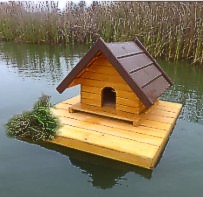


Duck island with duck house 01 [140] - Schwerin
(Germany): Duck island with duck house 02 hexagonal
[141] - Duck house in the region of Wismar (Germany) in
the Mill Creek (Mühlebach) [142]
There are no limits of fantasy for building these
small duck houses:
If the island is fixed, it must be designed to be flexible
for high and low water levels:

Duck island with duck house fixed on the floor with
ramps and play levels for high or low water level [146].
Book (German):
Schildkröten im Gartenteich von V.
Müller und W. Schmidt, Natur und Tier-Verlag,
16,80 Euro
In Europe there is only one species of water turtles, the
European pond turtle (Emys orbicularis orbicularis)
[web88], but they are very different depending on whether
they are Central European or Southern European aquatic
turtles, e.g. the Northern painted turtle (Chrysemys picta
bellii, picta, marginata), or the Northern red-bellied
turtle (Pseudemys rubriventris) [web89]. All other species
come from North "America" or from tropical Southeast Asia
[web88].
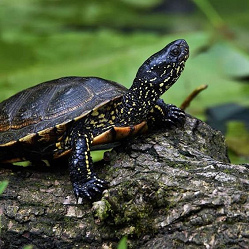
European pond turtle (Emys orbicularis orbicularis [154]
: Small aquatic
turtles up to 10cm are eaten by crows or cats, therefore
the aquatic turtles must be over 10cm long for being put
into a pond. Turtles need extensive shallow water areas up
to 20cm water depth with warm water, 2/3 of the pond
should be shallow water area and should be in the sun to
imitate tropical waters for Asian water turtles. You can
set up special basking (sunbeath) areas for aquatic
turtles, such as using a log in shallow water. When
threatened, aquatic turtles will retreat to deeper water
layers. ALL pond walls must rise relatively shallow
and be rough textured for the case if aquatic turtles want
to run to the water surface [web89].
For example, the pond edge of a turtle pond can consist of
flat stones where turtles can bask and warm up [web90].
Water turtles also love flat islands which are made of
flat stones [web91].
A water turtle pond can also be installed in a greenhouse
which is imitating tropical climate already, so they will
live there all year round [web89].
Aquatic turtles eat: The European pond
turtle does not eat aquatic plants, but eats amphibians
and insects. Aquatic turtles eat: Frogs, newts, tadpoles,
small hatchling newts. Other species, especially the
cooter turtle [from the "USA"], eat away all aquatic
plants, so that it is necessary to constantly put new
aquatic plants. For preventing the destruction of plants,
one has to feed them [web89].
Water turtles go with: Goldfish with short
fins, Asian koi. Shallow banks attract the heron, which
grabs a few fish there [web89].
Expeditions+phone number: water turtles like
to run away. A low fence is not enough, but only a 50cm
high wall is enough. You can write the owner's phone
number on the shell, with alcohol-based paint pen, so that
when you find it, it is immediately clear where the turtle
belongs to. After the turtle's skinning process, write it
again [web89].
Hibernation of aquatic turtles: Only the
European Pond Turtle from Eastern Europe and Russia
hibernates in a pond, at least 1m deep, where fish
hibernate as well. Ornamental forms of the European pond
turtle also overwinter in the cellar or refrigerator. All
other pond turtles from Southern Europe, from North
"America" and from Asia overwinter in the aquarium. In
spring or early summer the aquatic turtles are moved from
the aquarium to the pond, when the water temperature in
the aquarium and in the pond is the same [web89].


Water turtle aquarium from Walmart 01 [159] - Water
turtle aquarium double stock [160]
Home ponds for aquatic turtles
(photos are missing yet)
Turtle variations that should be kept in a pond in Central
Europe only during the summer months are:
-- the red-eared slider (Trachemys scripta elegans)
[web89] - originates from the southern "USA" and northern
Mexico [web95]
-- the eastern river cooter (Pseudemys concinna concinna)
[web89] - usually lives in the eastern "USA", also in the
Midwest [web94]
-- the yellow-bellied slider (Trachemys scripta scripta)
[web89] - usually lives in the SE "USA", esp. southern
Virginia+Florida [web93]
-- the Cumberland slider (Trachemys scripta troostii)
[web89] - usually lives in the Mississippi, up to Florida
[web92]
"American" and Asian aquatic turtles, which in Central
Europe are only living in the aquarium [or greenhouse]:
-- the map turtles (Graptemys species)
-- the Florida peninsula cooters (Pseudemys nelsoni)
-- the Peninsula ornate turtle (Pseudemys peninsularis)
-- the southern painted turtle (Chrysemys picta dorsalis)
-- the rred-bellied short-necked turtle (Emydura
subglobosa) tropical [web89].
Putting northern "American" turtles in Europe
outside: They will die because spring and fall
are much longer in Europe than in North "America," they
will die because of liver and kidney damage, or because
they don't know when to put their eggs because summer is
too cool in Europe [web89].
Water insects at the pond
Dragonflies, water flies, mosquitoes, etc.
24) Industrial breeding ponds
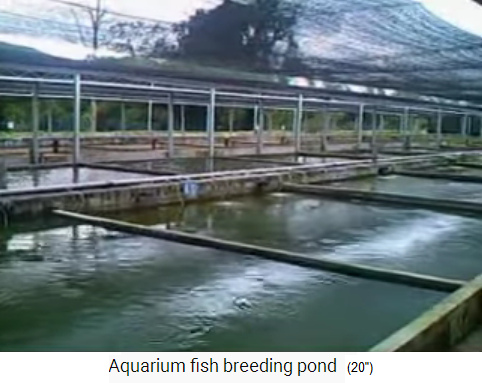
Industrial fish farm with concrete pond basins [129]
-- these are boring ponds in the fish industry, in extreme
cases simple concrete ponds in rows
-- there is heavy feeding and the water pollution at the
outlet is considerable [web09]
-- a permit for an industrial breeding pond is often
denied because of water pollution [web09]
-- using a filter trench between the inlet and the outlet
the charge of pollution into the public watercourse can be
reduced [web09].
-- in permaculture, breeding ponds are highly interesting
structures where all aquatic animals can develop, so
nothing needs to be added [web26,web27]
Construction of a fish breeding pond
Factor pond bottom with slope
The inlet must be higher than the outlet, the height
difference should be 20-30cm per 15m pond length. The
bottom of the pond should have a slope in order not to
have a lot of work when there is a fishing action by
drainage: After draining, all the remaining fish will
gather at the deepest place in front of the outlet, where
you can take them out with pleasure. These slopes in the
pond must be considered from the beginning [web07].
Trout pond: cool water
-- water with much oxygen, relatively cool water
-- inflow at least 10 liters per second (or circulation
pump with at least 10 l/s)
-- a long pond shape with 1 to 1 1/2m depth
-- pond monk at the end for constant water level or for
controlled draining of the pond [web09].

Cooiper Creek trout farm in Bryton, North Carolina,
"USA" [130]
-- carp need a large, shallow pond, with a plankton pond
next to it
-- pond bottom with a closed sward
-- after the floods in spring, wait until water warms and
sufficient zooplankton forms, because carps need high
water temperatures to spawn - carp specialists can use
hypophysis to encourage carp to spawn [web09]
-- then the cultivated fishes are fished off, the
youngsters develop until autumn, must receive daily
zooplankton from the plankton pond, later they are also
fed with pellets
-- you can combine carp fish with tench fish, which eat
the food remains on the bottom
-- in late autumn the pond is drained and the adult carps
are taken out [web09].

Carp pond at Berlin-Pankow, Germany [131].
by Sepp Holzer:
-- hiding places for the fishes are important, so the
hunting fishes cannot enter there in a root thicket
(3'7'') [web27]
-- these are the resting places for the small fish,
otherwise they will break down by stress or will be eaten
(3'21'') [web27]
-- if the many small animals live in the pond, you don't
need to feed the fish (1'5'') [web26]

Low zones in the pond with roots+ditches for small animals
in the pond [48].
25) Wintering in the pond from below 10ºC
If the water temperature drops permanently below 10ºC, the
pond should be prepared for wintering [OBI - web47]. So:
-- If there are pumps, fountains, pond lights and filter
systems, they must be all taken out
-- Leaves and debris must be taken out with a landing net
(net on a handle), sludge must be taken out, leaves must
be taken out with leaf protection net [web47]
-- For small ponds only up to 60cm depth, the fishes must
be taken out and put in winter quarters [web47]
-- Pond plants have to be pruned and thinned out, dead
plant remains have to be removed [web47]
-- Eventually it's possible to install an ice free holder
and a pond safety device in the pond [web47].
Fish hibernate from 80cm of water depth
-- the fish retreat to the deep zone, when the
temperatures are reducing under 8ºC, they fall into a kind
of winter rigidity, without movement, with minimal oxygen
consumption, without food intake [OBI - web47]
-- the pond must remain partially ice-free for sufficient
gas exchange [OBI - web47]
-- if sludge remains in the pond and "hibernates",
hydrogen sulfide and methane are released, which cannot
escape under a sheet of ice and dissolves in the water.
Consequently, the oxygen content in the pond water
decreases and fish and plants can suffocate [OBI - web47].
Cutting plants before winter
--
Water lilies overwinter without problems
from 80cm water depth; old yellow and dead leaves must be
removed in autumn [OBI - web47].
--
Underwater plants have to be carefully
thinned out with a rake, "but not all plants, as these
provide oxygen for the fish in the winter pond" [OBI -
web47]
--
Riparian plants (reeds, cane, etc.) have
to be thinned out [OBI - web47]
--
Rampant shore plants have to be cut to
15cm length above the water level - "Shore plants provide
gas exchange in the garden pond even in winter when the
ice cover is closed. Let's say, they act as "straws"."
[OBI - web47]
Get out tropical pond plants
-- water hyacinths [OBI - web47]
-- tropical water lilies [OBI - web47]
Overwintering is done "in a tub in a bright and
frost-proof place in the basement". If the plants were
planted in a plant basket, they can easily be taken out
[OBI - web47].
Install ice free holder and barrier
-- so that a hole is left open in the ice cover, for more
oxygen and less digester gas concentration [only needs it
if hardly any aquatic plants exist] [OBI - web47].
-- Ice free holders are: Styrofoam ring with cover, or
devices with sink chamber and pumping system [OBI -
web47].
During winter, install a barrier to prevent children from
falling into the pond [OBI - web47].
Translated mostly with Deepl.






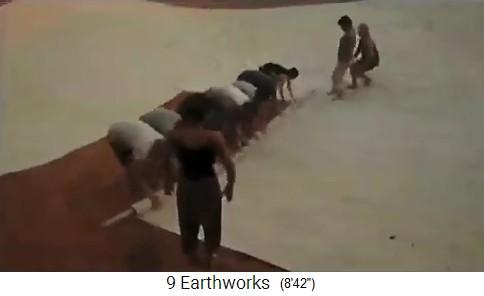




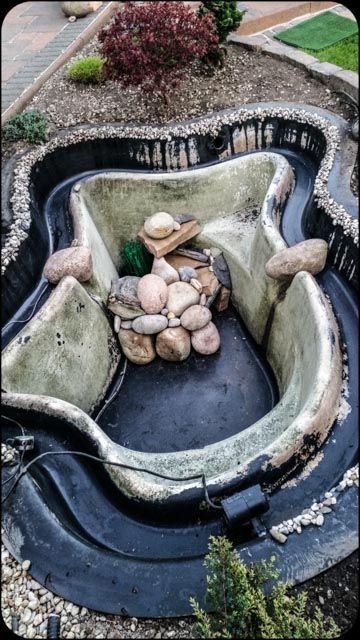


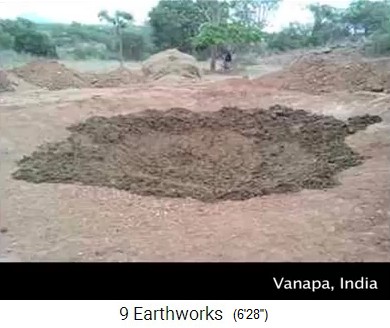








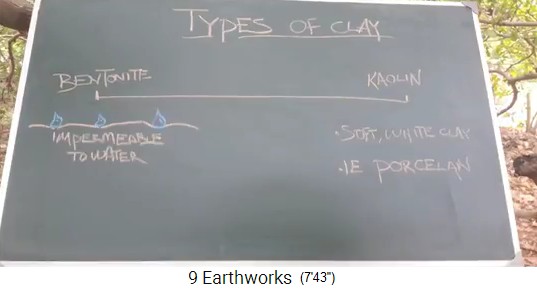
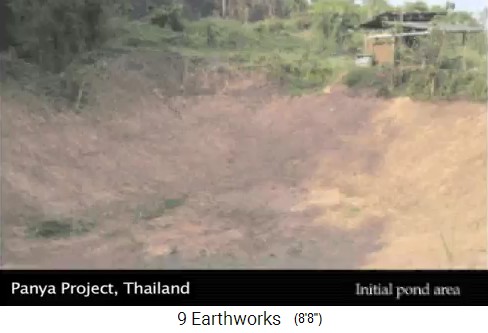
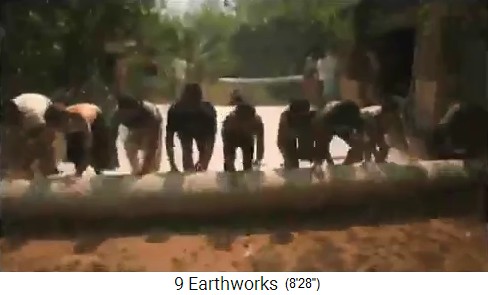
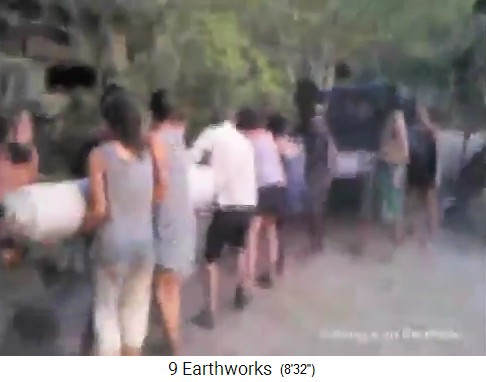
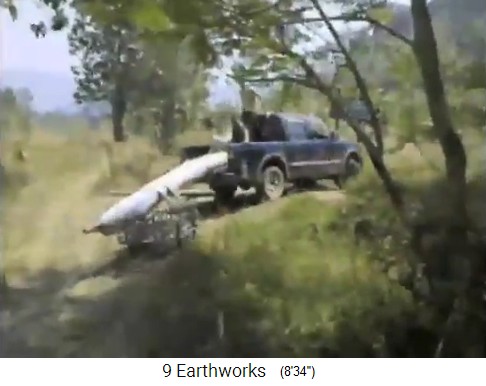
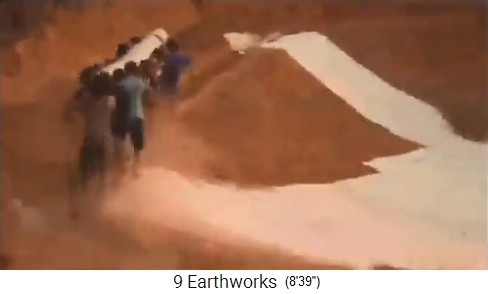
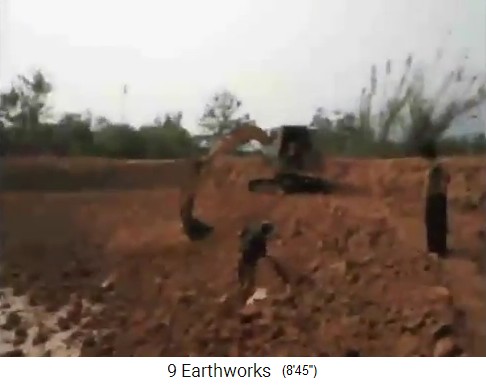

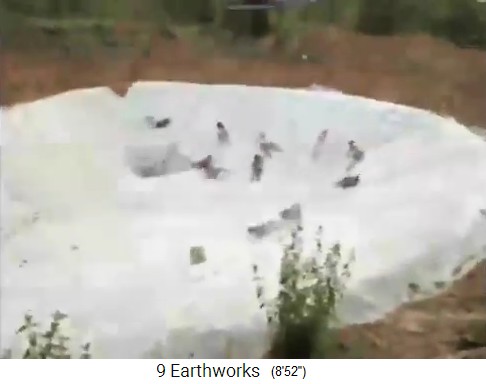

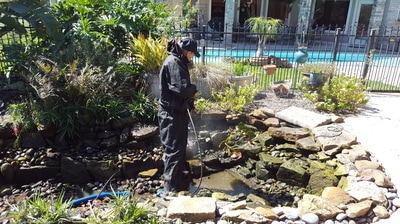


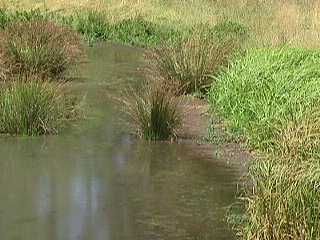


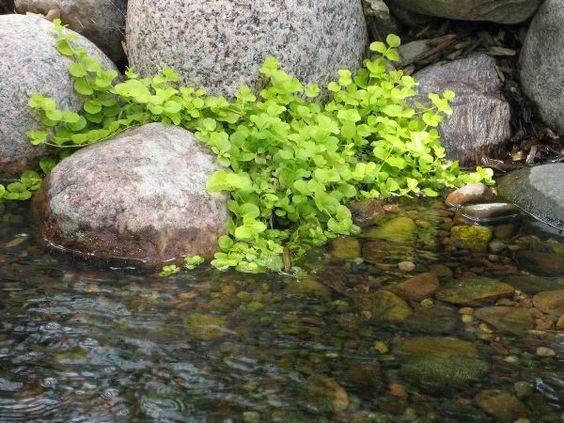


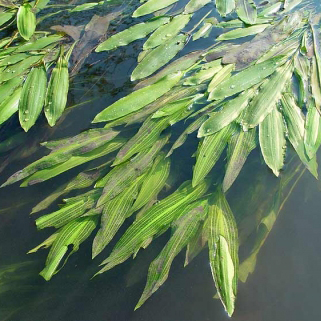


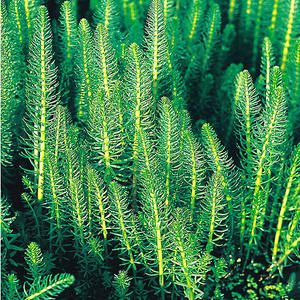

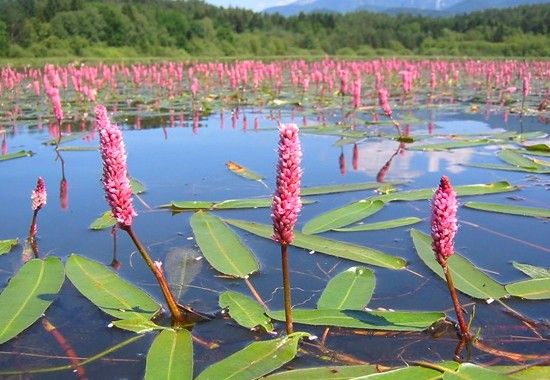
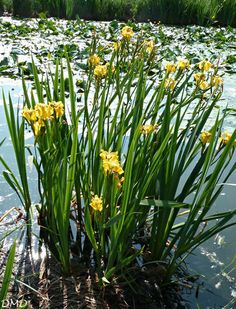

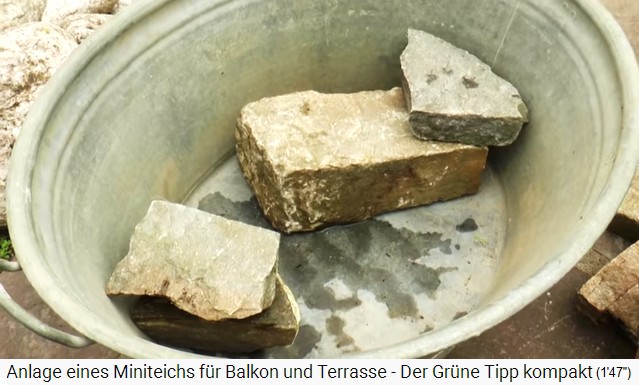


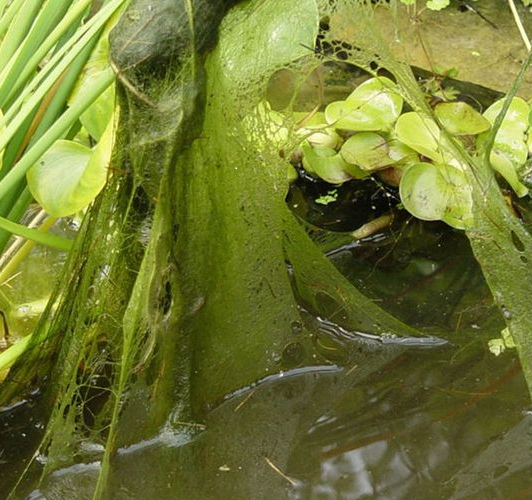
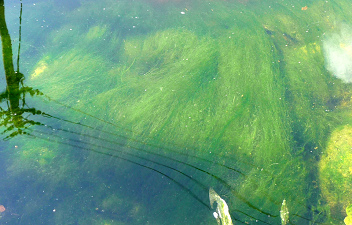
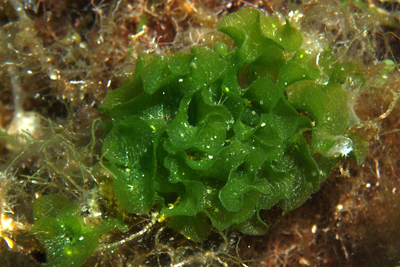
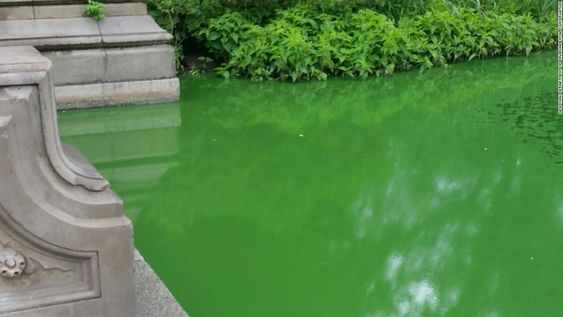
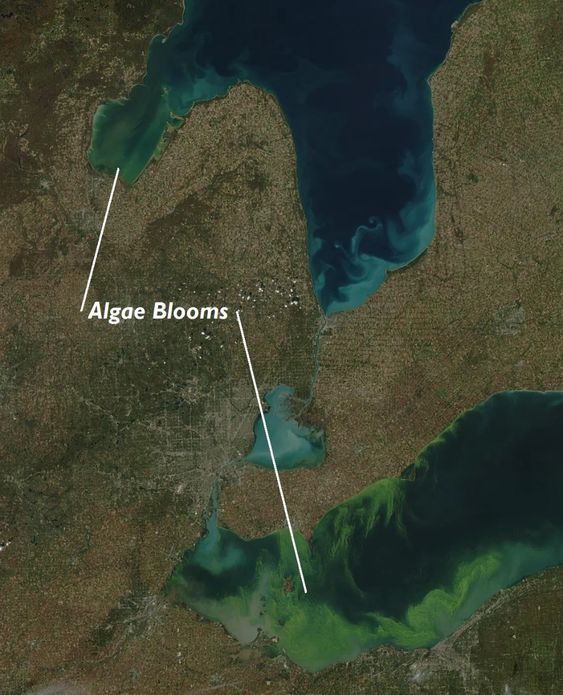



[28]
[29]












